Powder-Gas Jet Stream Characterisation Techniques in Laser Directed Energy Deposition: A Systematic Review
Abstract
1. Introduction
2. Methodology
- This review was not preregistered, which may introduce selection bias. To mitigate this, the search strategy, inclusion and exclusion criteria, and screening procedures were applied systematically and transparently described in this section.
- The literature search was conducted exclusively in the Scopus database, potentially limiting the inclusion of relevant studies indexed elsewhere.
- Publications in English were included, while grey literature and non-peer-reviewed sources were excluded.
- Additionally, studies based solely on numerical simulations were omitted unless experimental validation constituted a primary component.
3. Experimental Characterisation Techniques
3.1. Weight-Based Methods
3.2. Optical Methods
3.2.1. Lateral Camera Configuration
Area Illumination
Vertical Laser Line Illumination
Horizontal Laser Line Illumination
- Jardon et al. (2020) [10] used a 405 nm, 50 µm thick laser line, with a camera positioned in front of the nozzle. By varying the nozzle’s vertical position to scan the full powder cone and taking multiple images of the slices, the PGJS is reconstructed and the Df is calculated based on the intensity/concentration curves extracted from the image at different axial distances (see Figure 20, top left panel), and their local maxima (see Figure 20, top middle panel) are used for the shape reconstruction (see Figure 20, top right and bottom panels).
- The author developed a method involving image stacking and intensity analysis in concentric circles to create a radial-symmetric powder distribution profile, like the one presented by Ferreira et al. (2020) [17]. The Df is calculated as 14% of the maximum intensity measured within these circles, like the D86 method used in laser beam measurements. Furthermore, the intersection zone, where powder streams begin to merge, is identified by analysing the mean coefficient of variation (standard deviation divided by mean value) for these concentric circles, noting where this value decreases to a steady level within the smallest powder diameter region of interest.
- The captured images are then converted to greyscale, with the luminosity of pixels considered directly proportional to the relative density of powder particles. To determine the SOD, the greyscale values along the Z-axis (longitudinal profile) are analysed, and a Gaussian model is fitted to the data. The Z-coordinate of the highest point of this fitted curve is identified as the SOD. Subsequently, for measuring the Df, the greyscale values along the x-direction (transverse profile) are plotted and fitted, with the boundary of the powder spot precisely defined as the point where the greyscale value drops to 1/e2 of the maximum value on the fitted curve.
3.2.2. Coaxial Camera Configuration
3.3. Commercial Equipments
4. Discussion and Future Direction
4.1. Synthesis and Interpretation—Weight-Based Methods
4.2. Synthesis and Interpretation—Camera-Based Methods
Estimation of Powder-Gas Jet Stream Characteristics
- Motion blur and light trails: Longer exposure times can reduce the ability to identify single particles. Pre-processing techniques, such as sharpening filters, are usually applied to mitigate this effect [31].
- Camera resolution and pixel size: When pixel size is larger than the particle dimension, images become blurry and low-resolution, complicating particle tracking and identification [43]. This mismatch can also create pixel-locking artefacts, when a particle seems stuck to certain pixel positions instead of showing its real path [31].
- Light scattering: Scattering can cause powder particles to appear larger than their actual size, influencing the measured width and concentration [18].
- Particle overlap: Especially at high powder densities or in convergence zones, individual particles may no longer be resolved separately, instead appearing as agglomerates or a continuous flow, which can lead to increased measurement error [26].
- Interference factors: Reflected light from individual particles can appear discontinuous due to various interference factors [22].
4.3. Comparative Synthesis for PGJS Characterisation Methods
4.4. Lack of Standardisation
Minimum Reporting Set for Experimental Methods
- Nozzle geometry: Comprehensive details of the nozzle design should be provided, including the type (e.g., coaxial continuous or discrete), number of channels or jets, internal and external diameters, channel lengths, and inclination angles. The dimensions should be provided to avoid intellectual property claims.
- Material density, PSD and morphology: The type of material (alloy) and PSD should be reported using standard descriptors such as quartiles (Dv,n 10, 50, 90), average diameter and distribution mode. Information on particle shape (e.g., spherical, near spherical) supported by scanning electron microscope (SEM) micrographs is also relevant. Powder flowability data are also relevant, such as the ones obtained by the Hall/Carney funnel or powder rheology systems.
- SG, CG and PMF: Details on the type of gases used (e.g., argon, helium), volumetric flow rates (e.g., litres per minute or grams per minute), gas pressures, and flow rates for individual channels (e.g., inner and outer shielding gases) must be included.
- Particle trap method and dimensions: The technique employed to capture the particles should be specified (e.g., weighting method using a plate with a circular pinhole, or collection in cylindrical containers with specific concentric holes), including the diameter of the pinhole.
- Illumination wavelength and sheet thickness: The wavelength of the illumination and thickness of the laser sheet should be reported. If possible, provide the measured (not nominal) laser-sheet thickness and the method used to verify this measurement.
- Camera sensor and acquisition parameters: The camera type (e.g., CCD, CMOS, high-speed), spatial resolution (e.g., pixels, pixels per millimetre), frame rate (frames per second), exposure time (microseconds), and optical aperture settings (f-number) must be clearly documented.
- Pixel-to-Millimetre calibration: The scaling factor used to convert pixel measurements into real-world dimensions (e.g., micrometres per pixel or millimetres per pixel) must be provided to ensure measurement accuracy, including uncertainty of devices.
- Perspective/Homography or lens-distortion correction: Specify whether any perspective, homography, or lens-distortion were applied during image processing. Include the correction method and any parameters or calibration data used.
- Thresholding and fitting methods: Details on image binarisation procedures (e.g., Otsu, 1/e2 contour), criteria for defining particle boundaries (e.g., greyscale threshold values), and the mathematical functions used for fitting measurement data (e.g., Gaussian) should be included.
- Frames averaged: The number of frames stacked or averaged to reduce noise and discrete fluctuations, thereby producing a smoother representation of the powder stream, should be documented.
- Optical filters: Specifications of any optical filters employed to enhance image contrast should be reported, including bandpass filter centre wavelengths, FWHM, optical density, and the use of notch or other specialised filters.
5. Conclusions
Author Contributions
Funding
Data Availability Statement
Conflicts of Interest
Abbreviations
| 3D | Three-dimensional |
| 2D | Two-dimensional |
| CCD | Charge-coupled devices |
| CG | Carrier gas |
| CMOS | Complementary metal-oxide semiconductor |
| Df | Focus diameter |
| EIA | Edge identification algorithm |
| FPS | Frames per second |
| FWHM | Full width at half maximum |
| L-DEDp | Laser directed energy deposition process |
| MQTT | Message queuing telemetry transport |
| PGJS | Powder-gas jet stream |
| SG | Shielding gas |
| SOD | Stand-off distance |
| PIV | Particle image velocimetry |
| PMF | Powder mass flow |
| PSD | Particle size distribution |
| PSF | Point spread function |
| RPM | Revolutions per minute |
| TRL | Technology readiness level |
References
- Ahn, D.G. Directed Energy Deposition (DED) Process: State of the Art. Int. J. Precis. Eng. Manuf. Green. Tech. 2021, 8, 703–742. [Google Scholar] [CrossRef]
- Guner, A.; Bidare, P.; Jiménez, A.; Dimov, S.; Essa, K. Nozzle Designs in Powder-Based Direct Laser Deposition: A Review. Int. J. Precis. Eng. Manuf. 2022, 233, 1077–1094. [Google Scholar] [CrossRef]
- Kumar, S.P.; Elangovan, S.; Mohanraj, R.; Srihari, B. Critical review of off-axial nozzle and coaxial nozzle for powder metal deposition. Mater. Today Proc. 2021, 46, 8066–8079. [Google Scholar] [CrossRef]
- Pinkerton, A.J.; Li, L. Modelling Powder Concentration Distribution from a Coaxial Deposition Nozzle for Laser-Based Rapid Tooling. J. Manuf. Sci. Eng. 2025, 126, 33–41. [Google Scholar] [CrossRef]
- Gutjahr, J.; Pereira, M.; Sá De Sousa, J.M.; Ferreira, H.S.; Júnior, A.T. Powder degradation as a consequence of laser interaction: A study of SS 316L powder reuse on the laser directed energy deposition process. J. Laser Appl. 2024, 36, 012022. [Google Scholar] [CrossRef]
- Melo, L.D. Powder Jet Particle Density Distribution Analysis and Qualification for the Laser Metal Deposition Process. Master’s Thesis, Universidade Federal de Santa Catarina, Florianópolis, Brazil, 2015. Available online: https://repositorio.ufsc.br/xmlui/handle/123456789/171441 (accessed on 18 June 2025).
- Bohlen, A.; Seefeld, T.; Haghshenas, A.; Groll, R. Characterization of the powder stream propagation behavior of a discrete coaxial nozzle for laser metal deposition. J. Laser Appl. 2022, 34, 042048. [Google Scholar] [CrossRef]
- Zhong, C.; Pirch, N.; Gasser, A.; Poprawe, R.; Schleifenbaum, J.H. The Influence of the Powder Stream on High-Deposition-Rate Laser Metal Deposition with Inconel 718. Metals 2017, 7, 443. [Google Scholar] [CrossRef]
- Zhang, W.; Liu, Y.; Hu, D.; Lv, H.; Yang, Q. Experimental and numerical simulation studies of the flow characteristics and temperature field of Fe-based powders in extreme high-speed laser cladding. Opt. Laser Technol. 2024, 170, 110317. [Google Scholar] [CrossRef]
- Jardon, Z.; Guillaume, P.; Ertveldt, J.; Hinderdael, M.; Arroud, G. Offline powder-gas nozzle jet characterization for coaxial laser-based Directed Energy Deposition. Procedia CIRP 2020, 94, 281–287. [Google Scholar] [CrossRef]
- Baily, T. In-situ Monitoring of Powder Flow in Directed Energy Deposition Additive Manufacturing. Master’s Thesis, The Pennsylvania State University, University Park, PA, USA, 2021. [Google Scholar]
- ISO 11146-1:2021; Lasers and Laser-Related Equipment—Test Methods for Laser Beam Widths, Divergence Angles and Beam Propagation Ratios—Part 1: Stigmatic and Simple Astigmatic Beams. International Organization for Standardization—ISO: Geneva, Switzerland, 2021. Available online: https://www.iso.org/standard/77769.html (accessed on 12 September 2025).
- Bedenko, D.V.; Kovalev, O.B.; Sergachev, D.V. Numerical study of the gas-particle flows with the two-way coupling formed by coaxial nozzles for laser cladding. Surf. Coat. Technol. 2022, 445, 128700. [Google Scholar] [CrossRef]
- Eisenbarth, D.; Borges Esteves, P.M.; Wirth, F.; Wegener, K. Spatial powder flow measurement and efficiency prediction for laser direct metal deposition. Surf. Coat. Technol. 2019, 362, 397–408. [Google Scholar] [CrossRef]
- Liu, Z.; Zhang, H.; Peng, S.; Kim, H.; Du, D.; Cong, W. Analytical modeling and experimental validation of powder stream distribution during direct energy deposition. Addit. Manuf. 2019, 30, 100848. [Google Scholar] [CrossRef]
- Tabernero, I.; Lamikiz, A.; Ukar, E.; López De Lacalle, L.N.; Angulo, C.; Urbikain, G. Numerical simulation and experimental validation of powder flux distribution in coaxial laser cladding. J. Mater. Process. Technol. 2010, 210, 2125–2134. [Google Scholar] [CrossRef]
- Ferreira, E.; Dal, M.; Colin, C.; Marion, G.; Gorny, C.; Courapied, D.; Guy, J.; Peyre, P. Experimental and Numerical Analysis of Gas/Powder Flow for Different LMD Nozzles. Metals 2020, 10, 667. [Google Scholar] [CrossRef]
- Kim, H.S.; Park, S.H. Influence of high powder flow dynamics on the efficiency of laser-directed energy deposition. Mater. Des. 2025, 255, 114145. [Google Scholar] [CrossRef]
- Schopphoven, T.; Pirch, N.; Mann, S.; Poprawe, R.; Häfner, C.L.; Schleifenbaum, J.H. Statistical/Numerical Model of the Powder-Gas Jet for Extreme High-Speed Laser Material Deposition. Coatings 2020, 10, 416. [Google Scholar] [CrossRef]
- Zekovic, S.; Dwivedi, R.; Kovacevic, R. Numerical simulation and experimental investigation of gas–powder flow from radially symmetrical nozzles in laser-based direct metal deposition. Int. J. Mach. Tools Manuf. 2007, 47, 112–123. [Google Scholar] [CrossRef]
- Ancalmo, C.; Narra, S.P. Prediction of the powder catchment efficiency and melt track height in laser directed energy deposition. J. Manuf. Process. 2025, 137, 207–220. [Google Scholar] [CrossRef]
- Jing, P.; Qin, J.; Li, Y.; Zhu, H.; Zhong, S.; Zhang, L. Analysis of concentration distribution, flight characteristics, and laser-powder interaction in Ni-based diamond powder laser cladding. Opt. Laser Technol. 2025, 187, 112789. [Google Scholar] [CrossRef]
- Warneke, P.; Westermeyer, L.; Bohlen, A.; Seefeld, T. Influencing the powder particle transport in high-speed laser melt injection. J. Laser Appl. 2024, 36, 042023. [Google Scholar] [CrossRef]
- Bohlen, A.; Seefeld, T. Influence of the inner roughness of powder channels on the powder propagation behavior in laser metal deposition. J. Laser Appl. 2024, 36, 042007. [Google Scholar] [CrossRef]
- Pacheco, J.T.; Prass, G.; Veiga, M.; Meura, V.; Leite, M.; Fiocco, G.; Rego, R. Influence of carrier gas flow rate and particle size of AISI M2 in the laser-directed energy deposition process. Adv. Mater. Process. Technol. 2024, 11, 1836–1850. [Google Scholar] [CrossRef]
- López-Martínez, A.; Ibarra-Medina, J.; García-Moreno, A.; Piedra, S.; Vizcaya, L.D.L.; Martínez-Franco, E.; Megahed, M. Modeling and comparison of the powder flow dynamics for tilted annular and discrete-outlet nozzles in laser directed energy deposition. J. Manuf. Process. 2023, 99, 687–704. [Google Scholar] [CrossRef]
- Touzé, S.; Rauch, M.; Hascoët, J. Gas-particle flow of cohesive aluminium powders during laser metal deposition—Experimental and numerical investigation. Adv. Powder Technol. 2023, 34, 104182. [Google Scholar] [CrossRef]
- Bian, Y.; He, X.; Yu, G.; Li, S.; Tian, C.; Li, Z.; Zhang, Y.; Liu, J. Powder-flow behavior and process mechanism in laser directed energy deposition based on determined restitution coefficient from inverse modeling. Powder Technol. 2022, 402, 117355. [Google Scholar] [CrossRef]
- Cui, Y.H.; Wu, L.L.; Yang, Y.C.; Lan, Y.C.; Lin, J.L.; Fang, N.W.; Chen, X.Y.; Li, R. Analysis of Powder Feeding Behaviour in Coaxial Laser Cladding. Lasers Eng. 2022, 42, 361–374. [Google Scholar]
- Li, L.; Huang, Y.; Zou, C.; Tao, W. Numerical Study on Powder Stream Characteristics of Coaxial Laser Metal Deposition Nozzle. Crystals 2021, 11, 282. [Google Scholar] [CrossRef]
- García-Moreno, A.; Alvarado-Orozco, J.; Ibarra-Medina, J.; López-Martínez, A.; Martínez-Franco, E. A new PIV method to measure powder flow velocity in laser metal deposition: An Eulerian-based approach. Int. J. Adv. Manuf. Technol. 2021, 117, 1825–1841. [Google Scholar] [CrossRef]
- Mahmood, M.A.; Popescu, A.C.; Oane, M.; Ristoscu, C.; Chioibasu, D.; Mihai, S.; Mihailescu, I.N. Three-Jet Powder Flow and Laser–Powder Interaction in Laser Melting Deposition: Modelling Versus Experimental Correlations. Metals 2020, 10, 1113. [Google Scholar] [CrossRef]
- Kovalev, O.B.; Bedenko, D.V.; Gurin, A.M.; Sergachev, D.V. Study of optimization features of gas-powder jets created by a coaxial nozzle with divided powder supply during direct laser deposition of materials. Opt. Laser Technol. 2025, 181, 112020. [Google Scholar] [CrossRef]
- Kim, H.S.; Park, S.H. Powder stream characteristics of replaceable alumina and brass nozzle tips for directed energy deposition. Addit. Manuf. 2025, 102, 104734. [Google Scholar] [CrossRef]
- Platz, J.; Steiner-Stark, J.; Kirsch, B.; Aurich, J.C. Investigation on different laser-powder alignments and their influence on part properties in high-speed Directed Energy Deposition. Procedia CIRP 2024, 124, 190–193. [Google Scholar] [CrossRef]
- Pant, P.; Chatterjee, D.; Kumar, S.; Kumar Lohar, A. Experimental and Numerical Analysis of the Powder Flow in a Multi-Channel Coaxial Nozzle of a Direct Metal Deposition System. J. Manuf. Sci. Eng. 2021, 143, 071003. [Google Scholar] [CrossRef]
- Nagulin, K.Y.; Iskhakov, F.R.; Shpilev, A.I.; Gilmutdinov, A.K. Optical diagnostics and optimization of the gas-powder flow in the nozzles for laser cladding. Opt. Laser Technol. 2018, 108, 310–320. [Google Scholar] [CrossRef]
- Katinas, C.; Shang, W.; Shin, Y.C.; Chen, J. Modeling Particle Spray and Capture Efficiency for Direct Laser Deposition Using a Four Nozzle Powder Injection System. J. Manuf. Sci. Eng. 2018, 140, 041014. [Google Scholar] [CrossRef]
- Shpilev, A.I.; Iskhakov, F.R.; Nagulin, K.Y.; Gil’mutdinov, A.K. Gas and Powder Flow Optimization in a Four-Jet Laser Cladding Head. Russ. Aeronaut. 2018, 61, 145–148. [Google Scholar] [CrossRef]
- Balu, P.; Leggett, P.; Kovacevic, R. Parametric study on a coaxial multi-material powder flow in laser-based powder deposition process. J. Mater. Process. Technol. 2012, 212, 1598–1610. [Google Scholar] [CrossRef]
- Pang, M.; Wu, Z.; Sun, S.; Wang, H.; Yang, R.; Wu, Y.; Cai, G. Numerical simulation and experimental investigation of the influence of gas flows in extreme high speed laser cladding. Opt. Laser Technol. 2025, 188, 113002. [Google Scholar] [CrossRef]
- Hildinger, P.; Seefeld, T.; Bohlen, A. Image Based In-Process Powder Stream Monitoring during Laser Metal Deposition for the Measurement of the Gravimetric Powder Mass Flow Rate and the Detection of Deviations in the Powder Stream. Procedia CIRP 2024, 124, 219–222. [Google Scholar] [CrossRef]
- Brucki, M.; Schmickler, T.; Gasser, A.; Häfner, C.L. Influence of the Relative Position of Powder–Gas Jet and Laser Beam on the Surface Properties of Inconel 625 Coatings Produced by Extreme High-Speed Laser Material Deposition (EHLA). Coatings 2023, 13, 998. [Google Scholar] [CrossRef]
- Hildinger, P.; Seefeld, T.; Bohlen, A. Characterization of optical emissions during laser metal deposition for the implementation of an in-process powder stream monitoring. J. Laser Appl. 2023, 35, 042048. [Google Scholar] [CrossRef]
- Ponticon GmbH. Why Does PowderSpy Exist? 2024. Available online: https://ponticon.de/wp-content/uploads/2024/04/240305_PowderSpy-Specification.pdf (accessed on 19 July 2025).
- Ponticon GmbH. Report PowderSpy Example. 2023. Available online: https://ponticon.de/en/powderspy/ (accessed on 19 July 2025).
- Fraunhofer IWS. LIsec Powder Nozzle Qualification Device. 2024. Available online: https://www.iws.fraunhofer.de/content/dam/iws/en/documents/publications/product-sheets/2024_Product-Sheet_LIsec_EN.pdf (accessed on 19 July 2025).
- Fraunhofer Gesellschaft zur Forderung der Angewandten Forschung. Method and Device for Detecting a Particle Density Distribution in the Jet of a Nozzle. DE Patent DE102011009345B3, 25 January 2011. [Google Scholar]
- Lin, J. Concentration mode of the powder stream in coaxial laser cladding. Opt. Laser Technol. 1999, 31, 251–257. [Google Scholar] [CrossRef]
- Guo, S.; Song, S.; Cui, L.; Cui, Y.; Li, X.; Chen, Y.; Zheng, B. Influence of Defocusing Amount on Powder Flow Convergence Characteristics and Forming Microstructure of Coaxial Powder Feeding Laser Cladding. J. Mater. Eng. Perform. 2023, 33, 13237–13250. [Google Scholar] [CrossRef]
- Tan, Y.; Lin, F.; Ali, M.; Su, Z.; Wong, H. Development of a novel beam profiling prototype with laser self-mixing via the knife-edge approach. Opt. Lasers Eng. 2023, 169, 107696. [Google Scholar] [CrossRef]
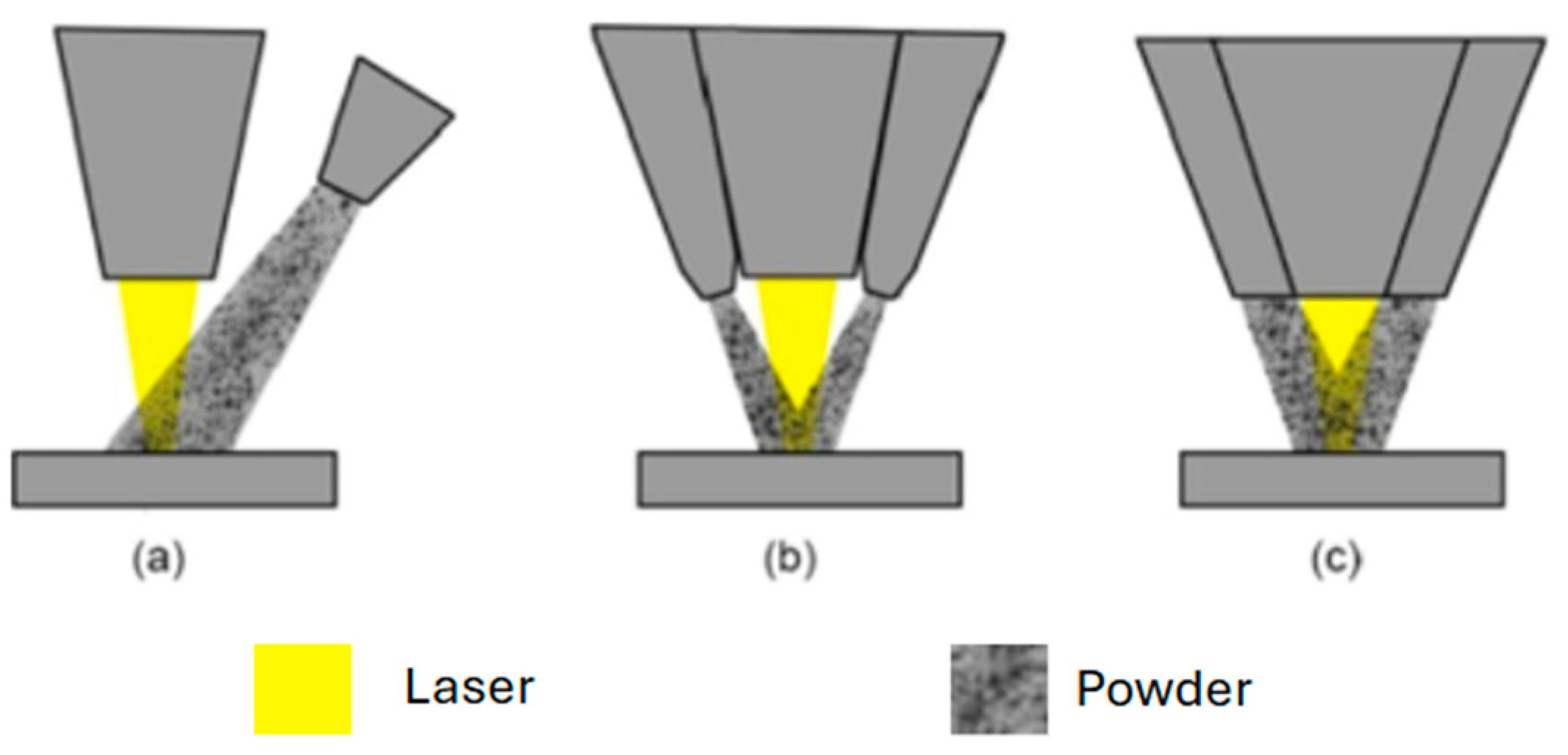
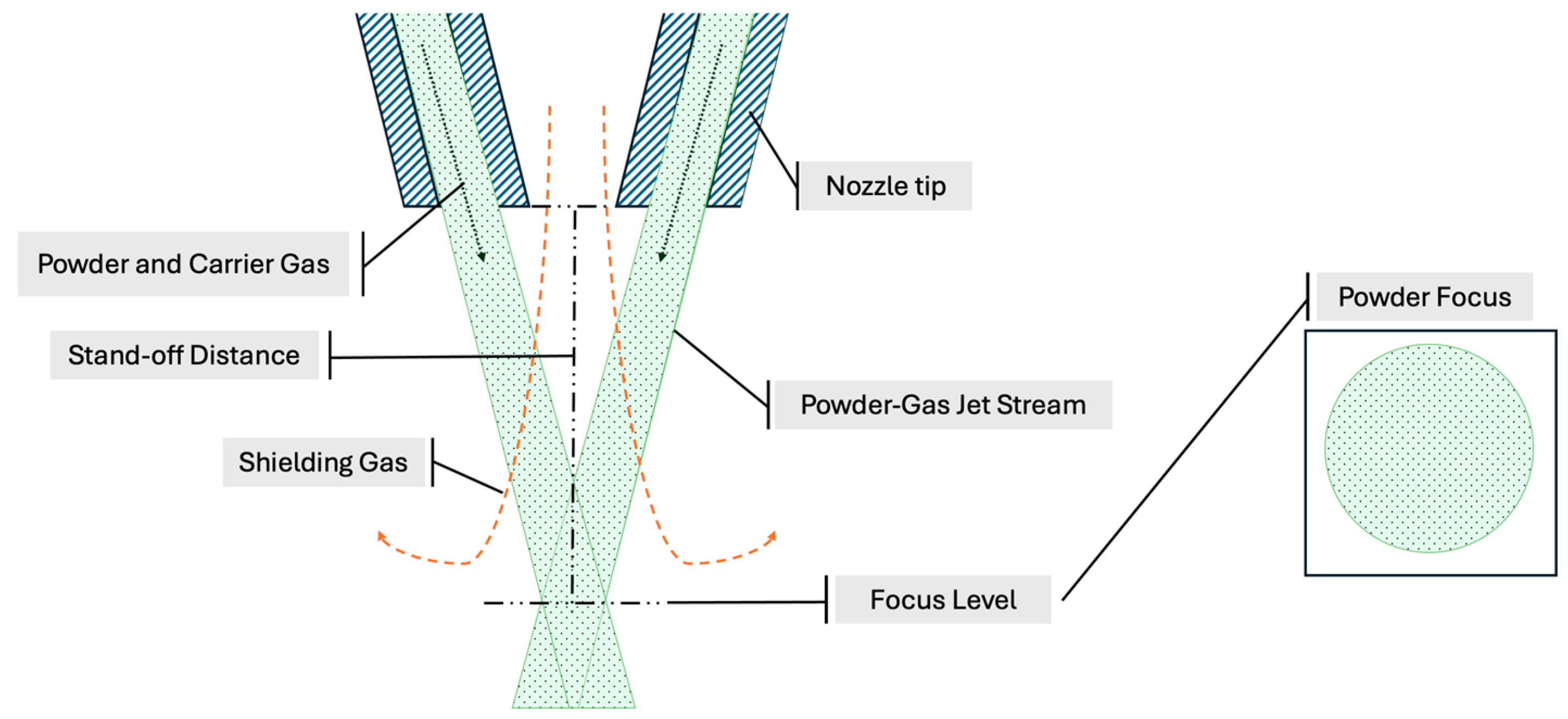
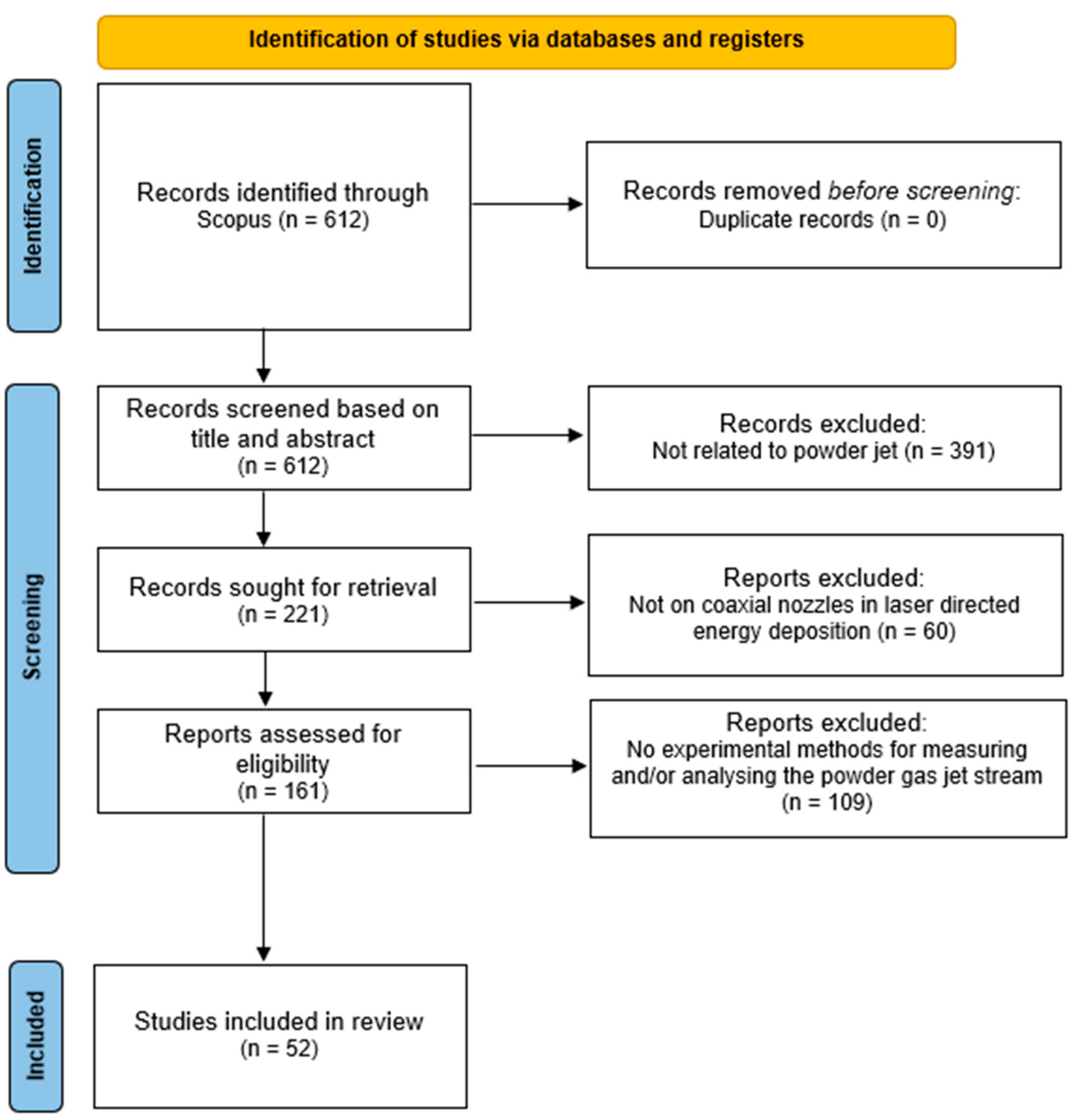

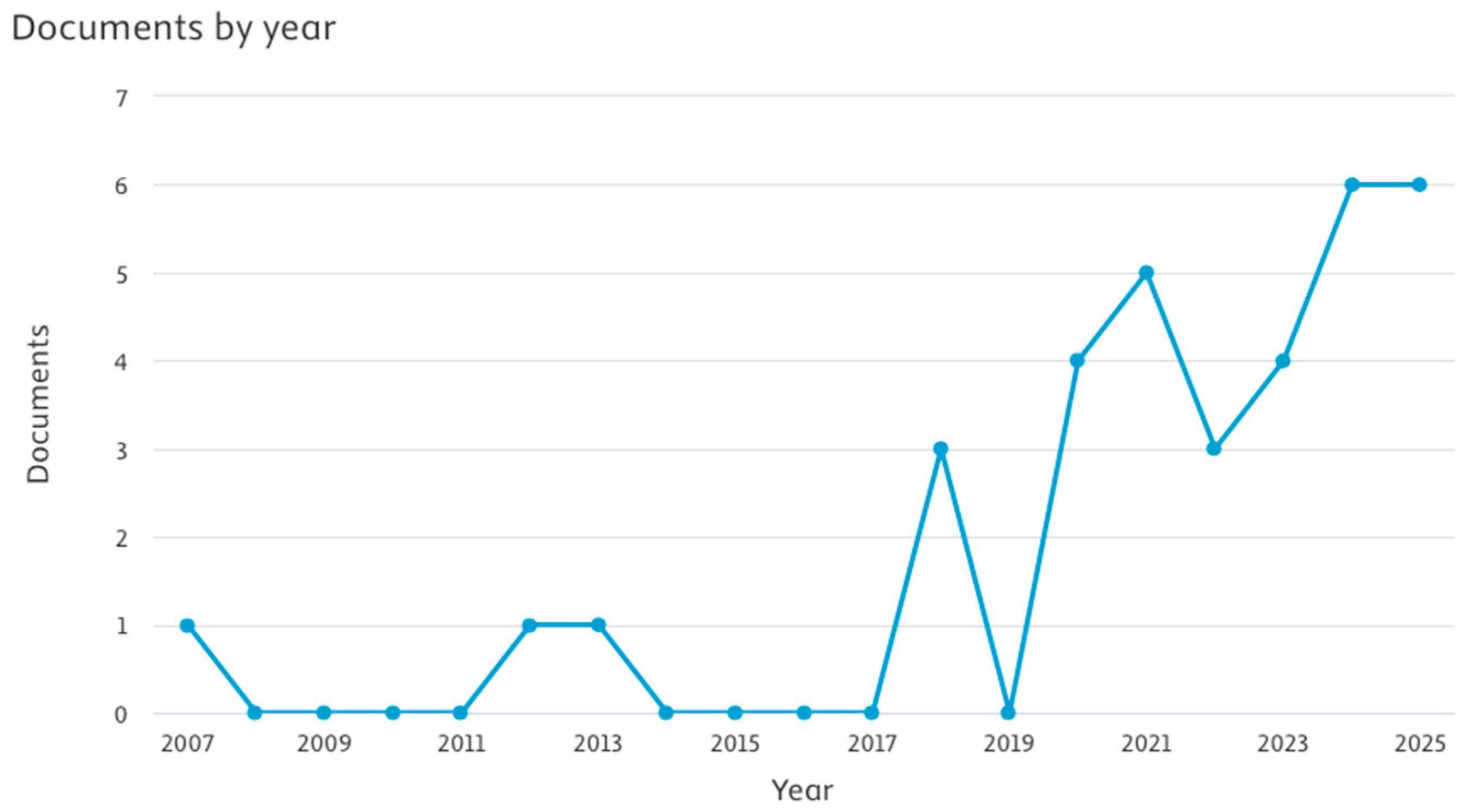
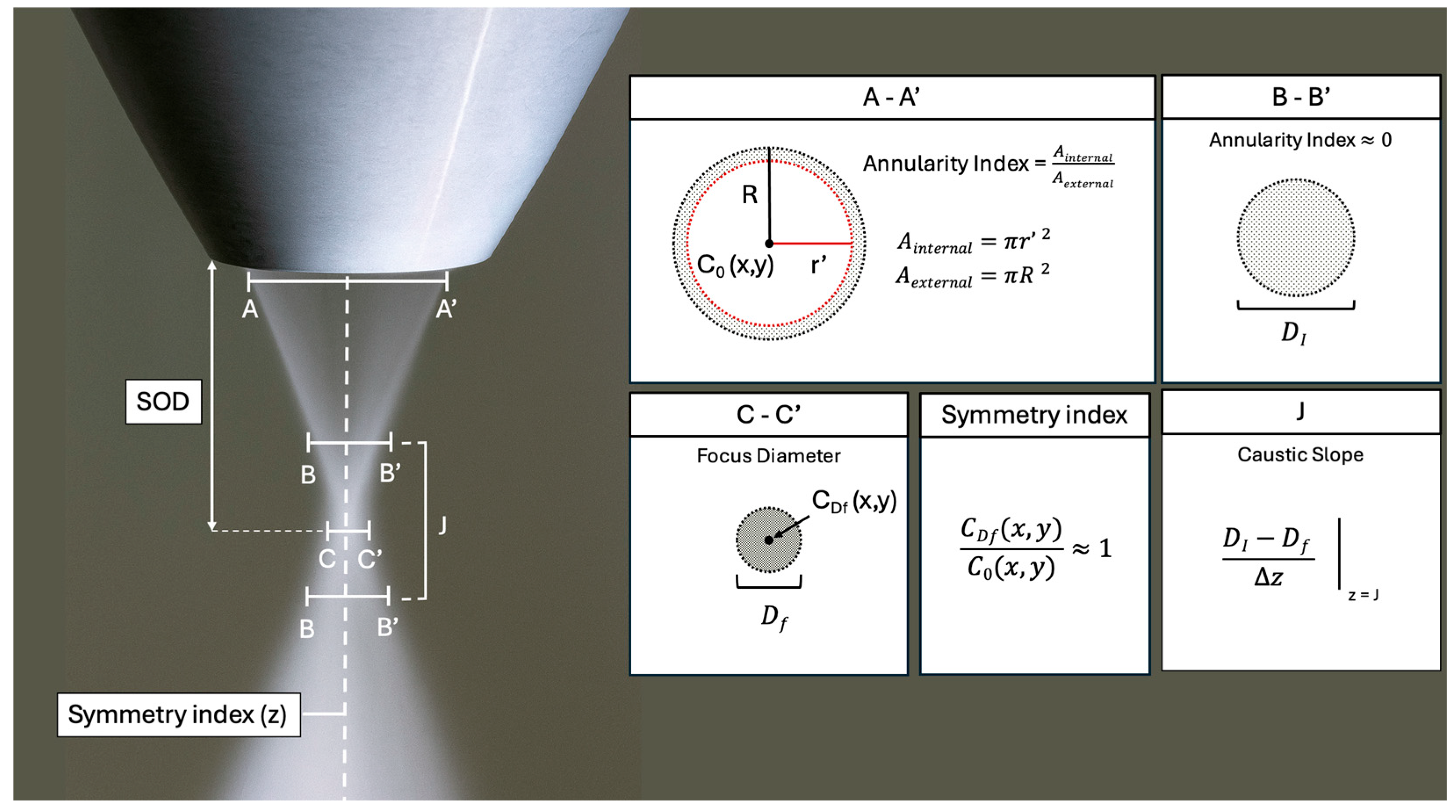

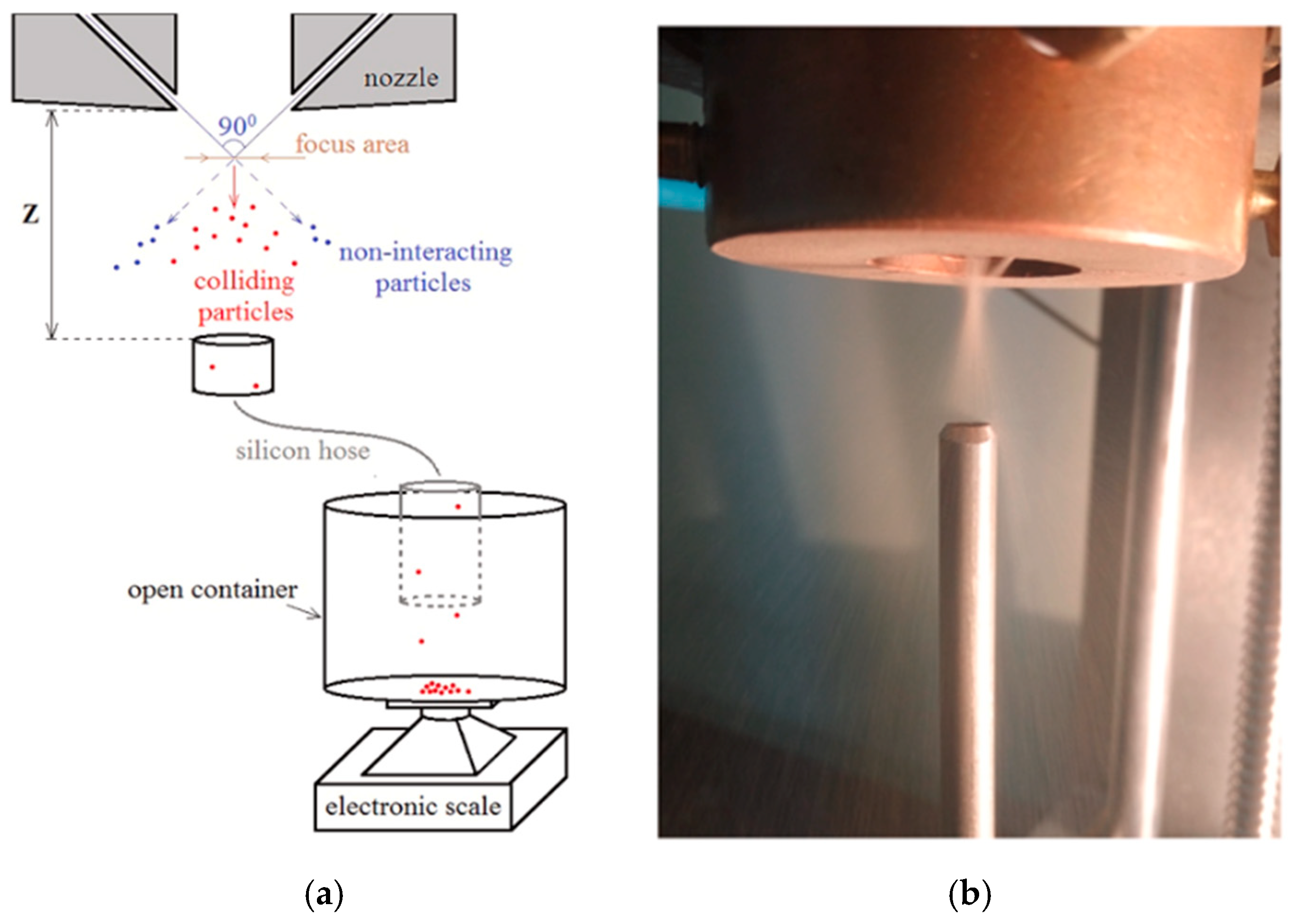
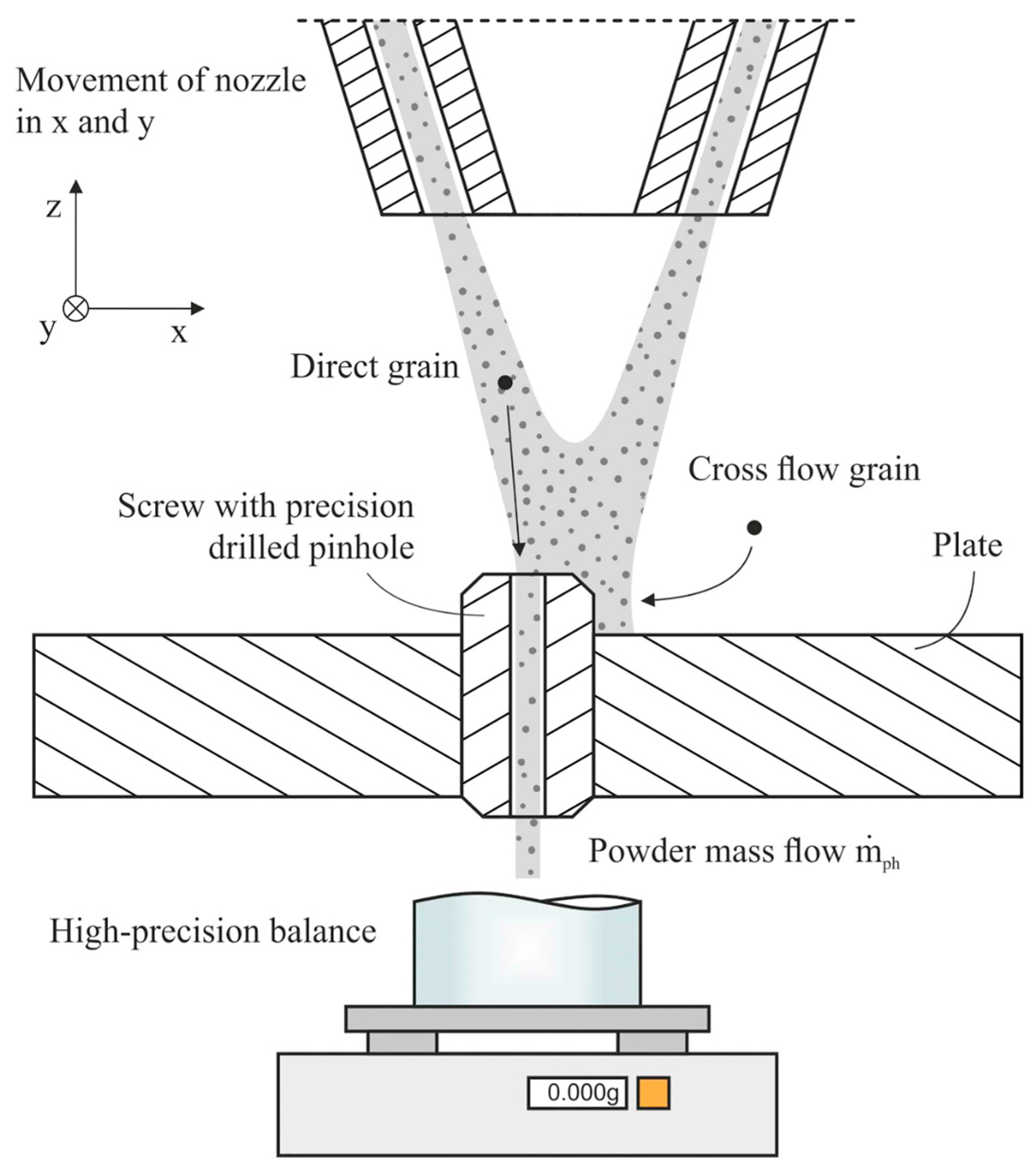
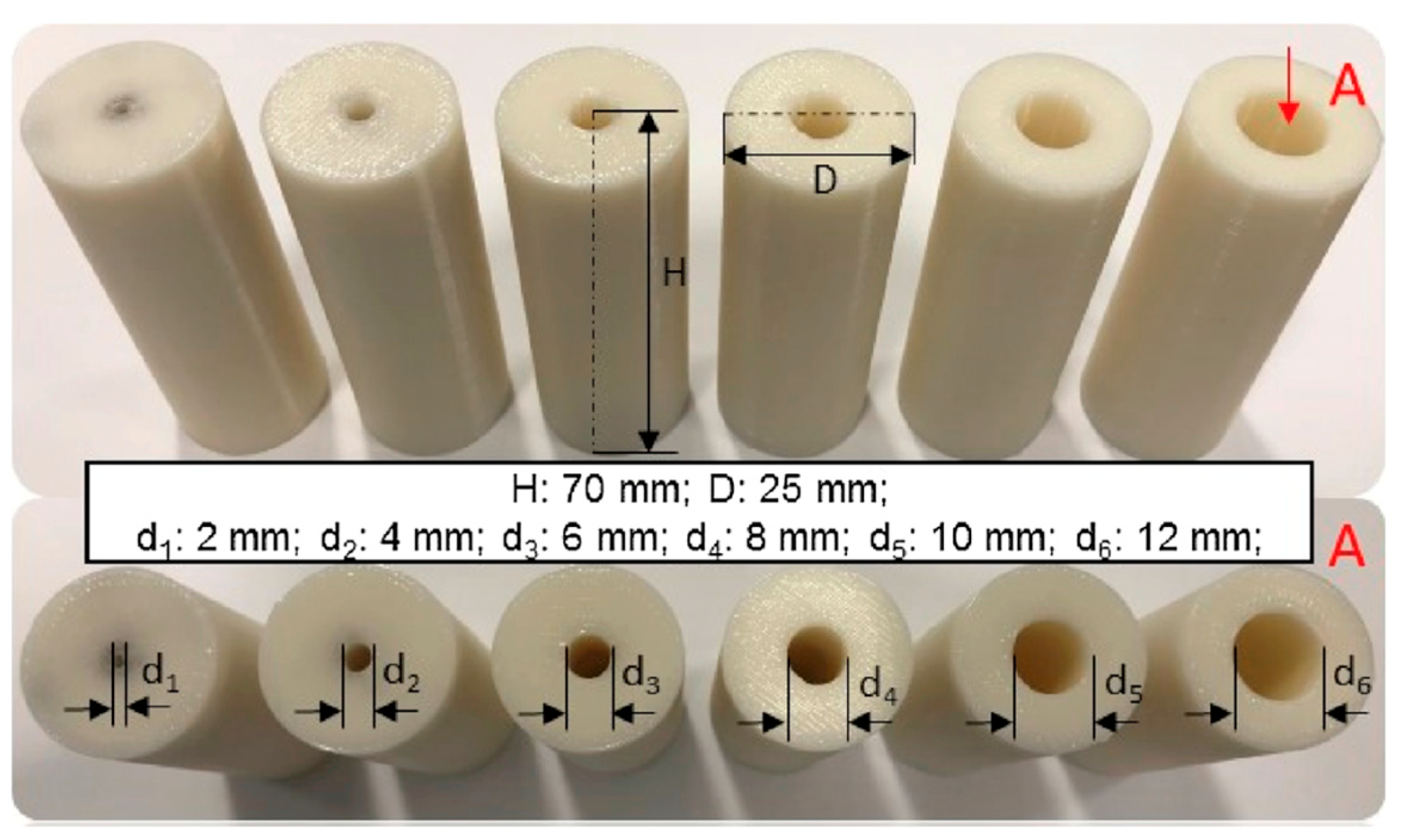
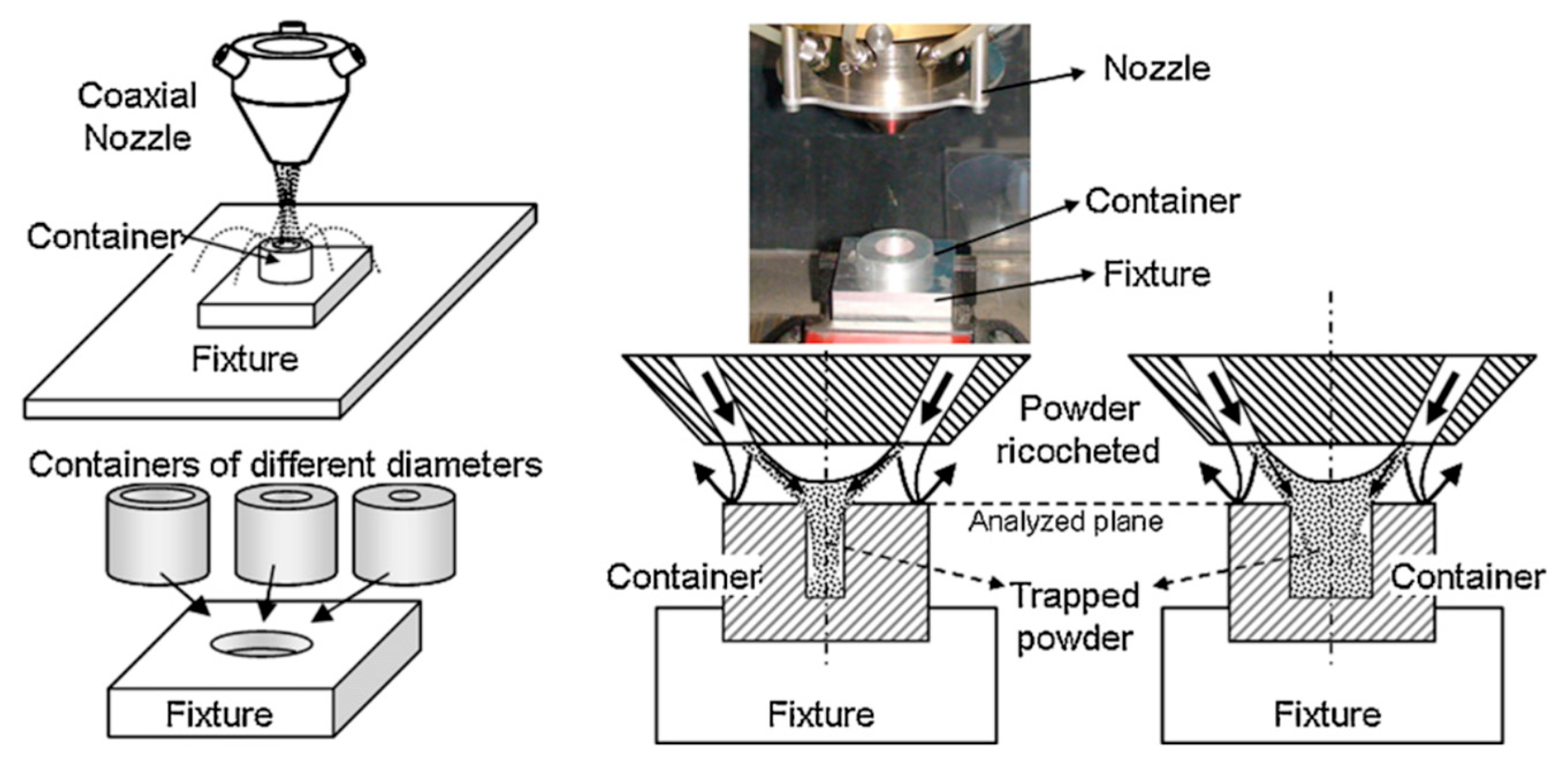
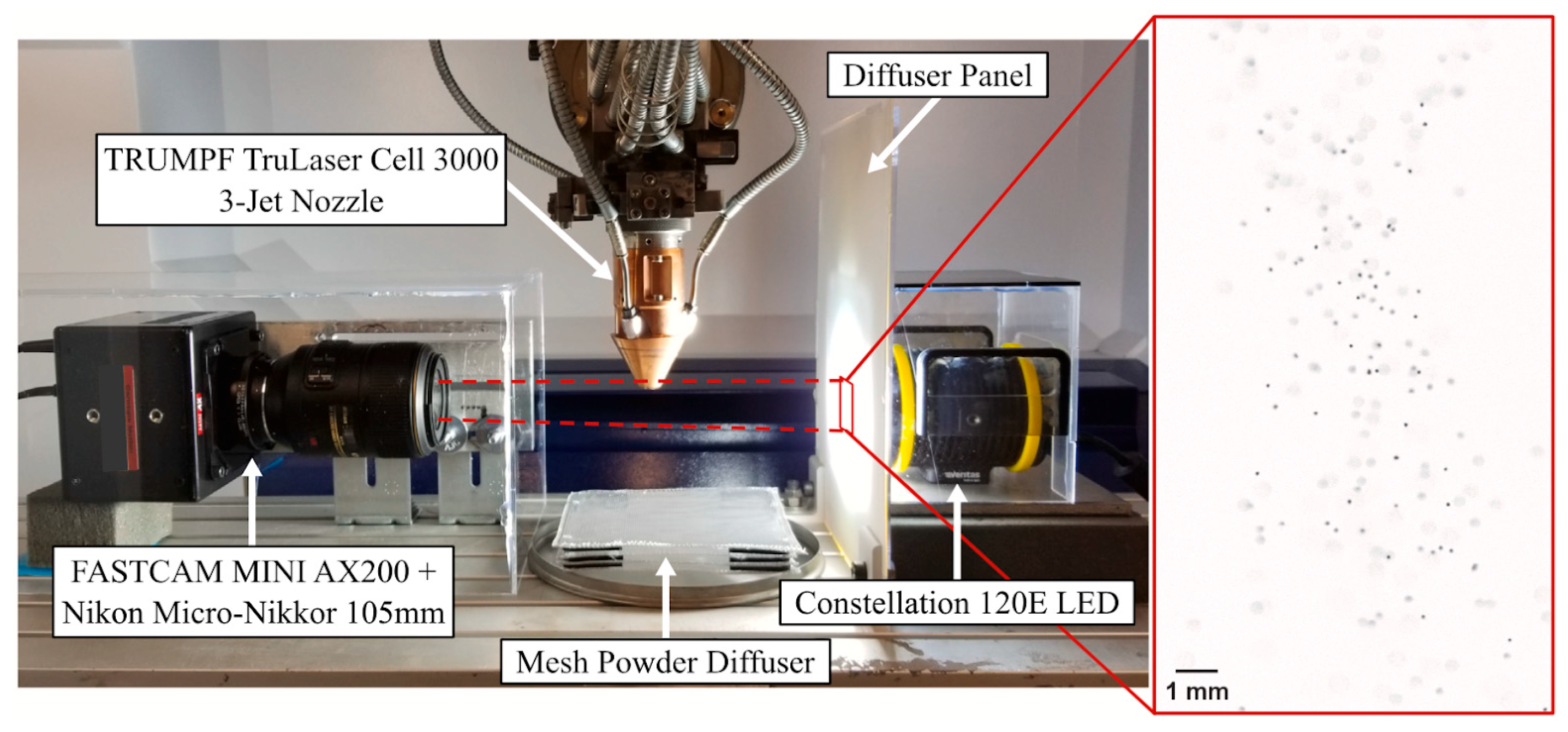
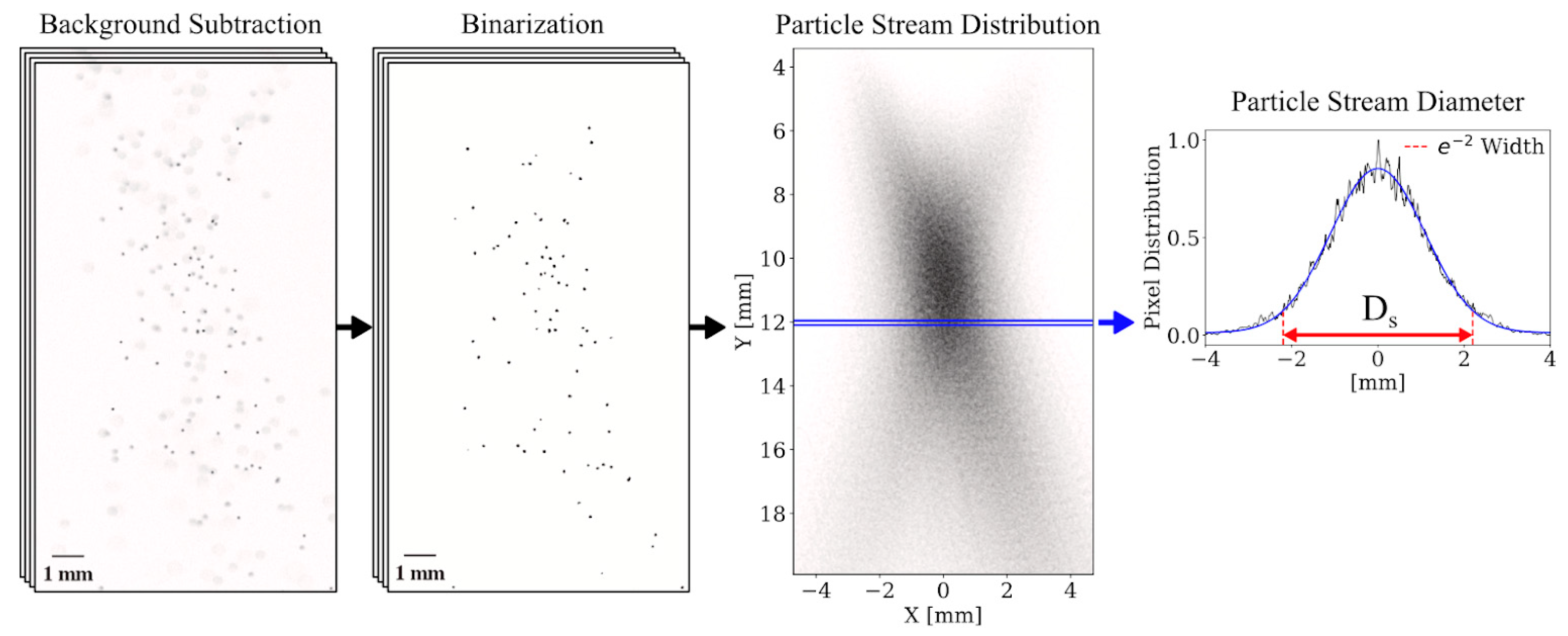

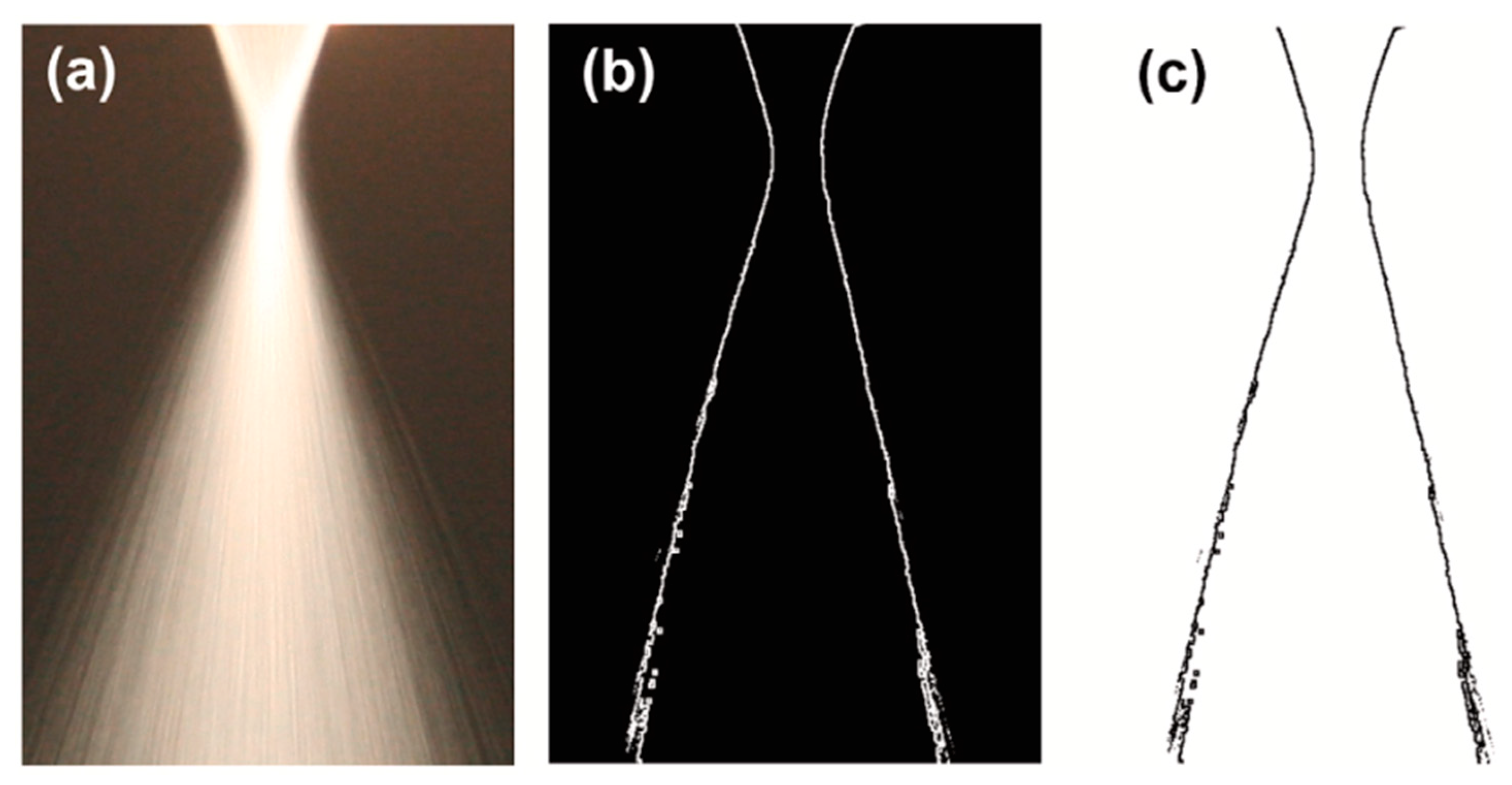
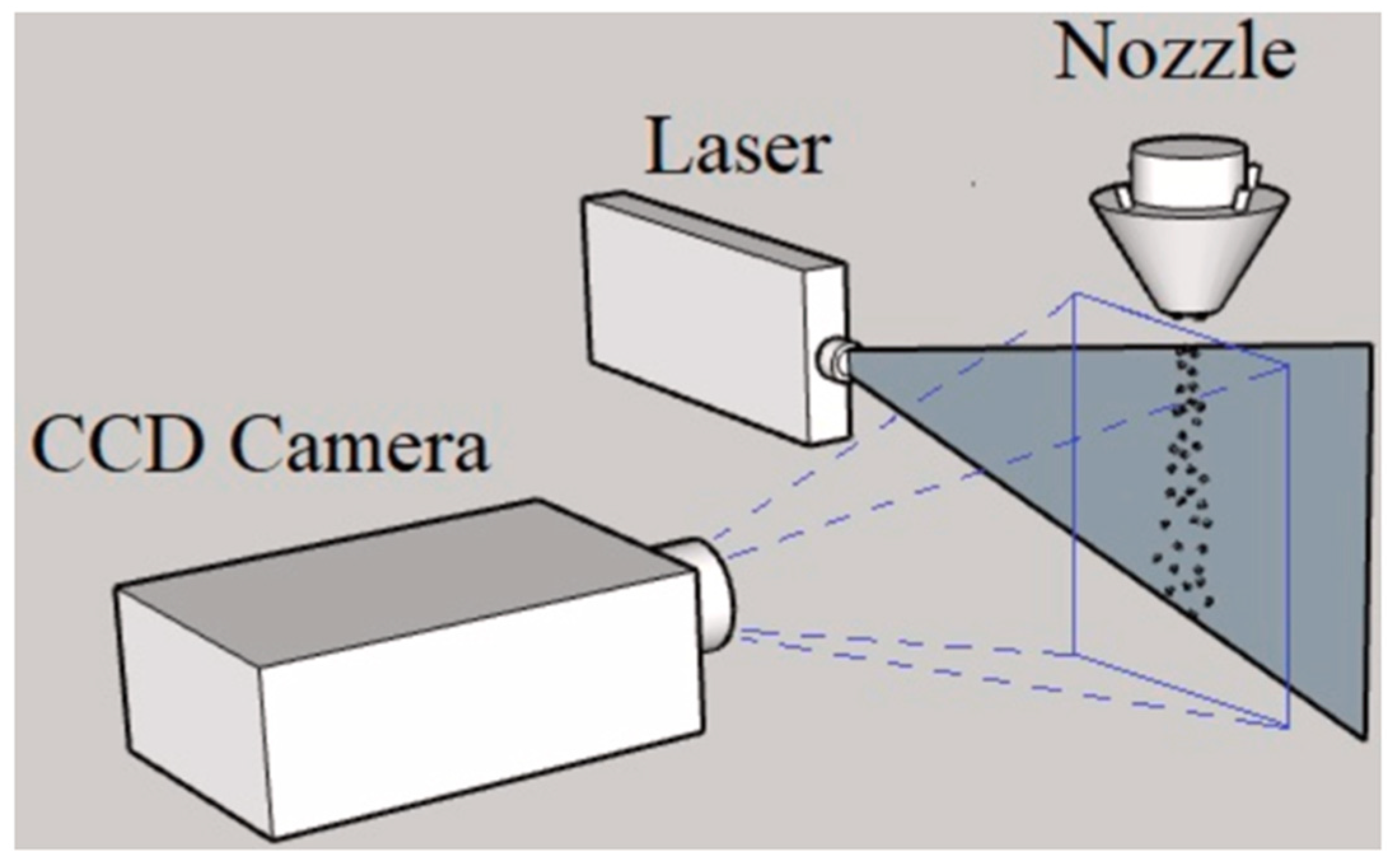
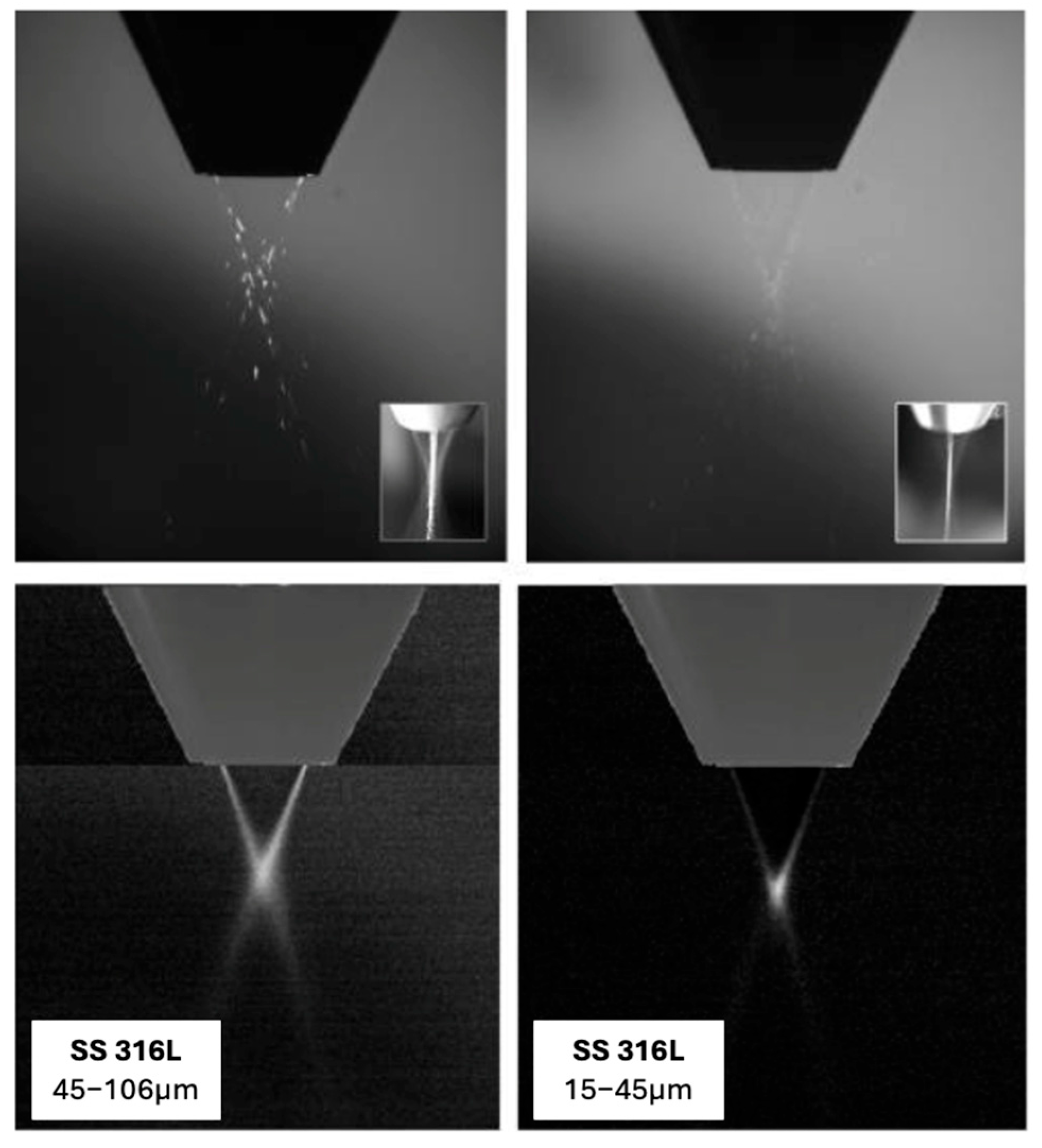
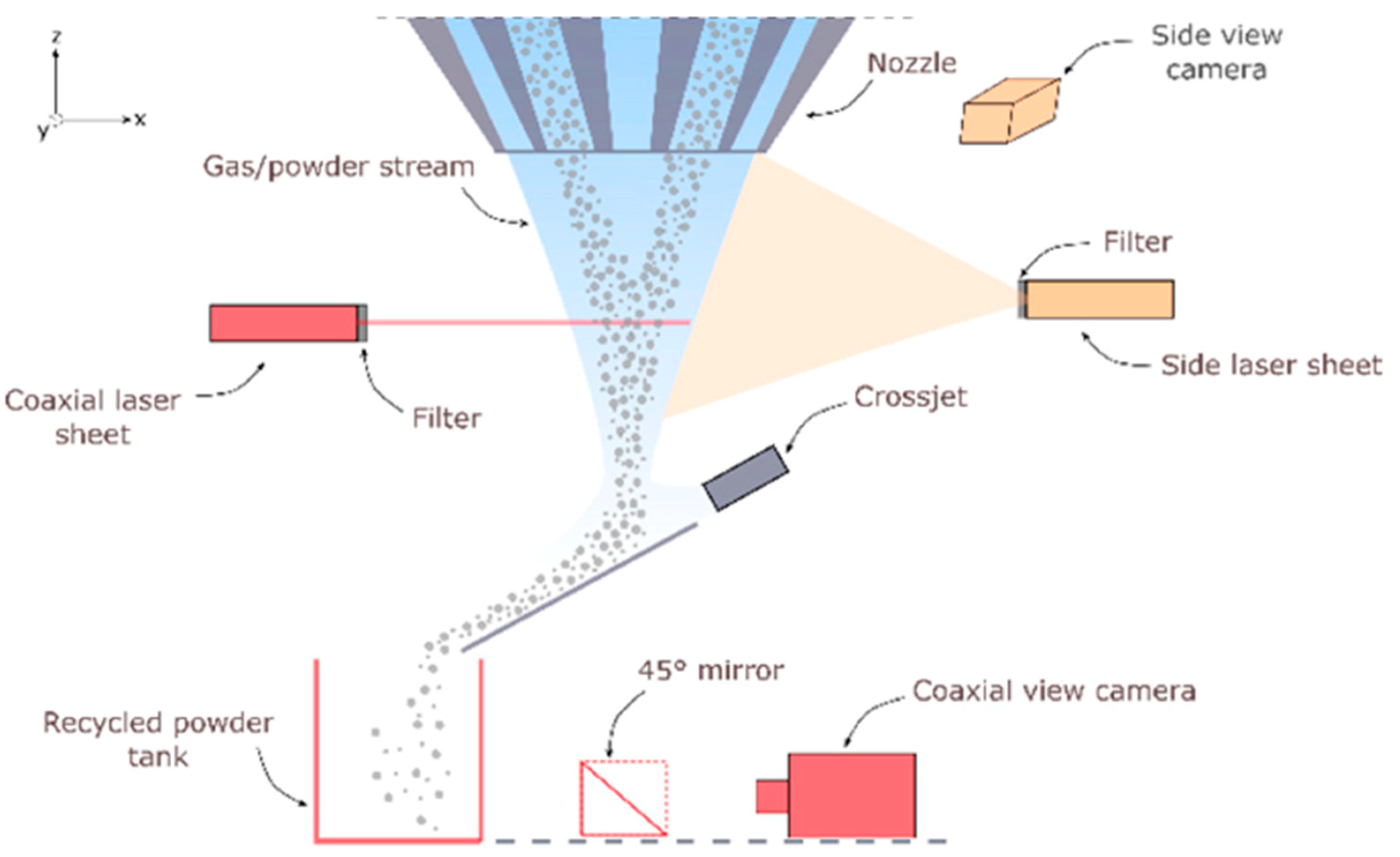
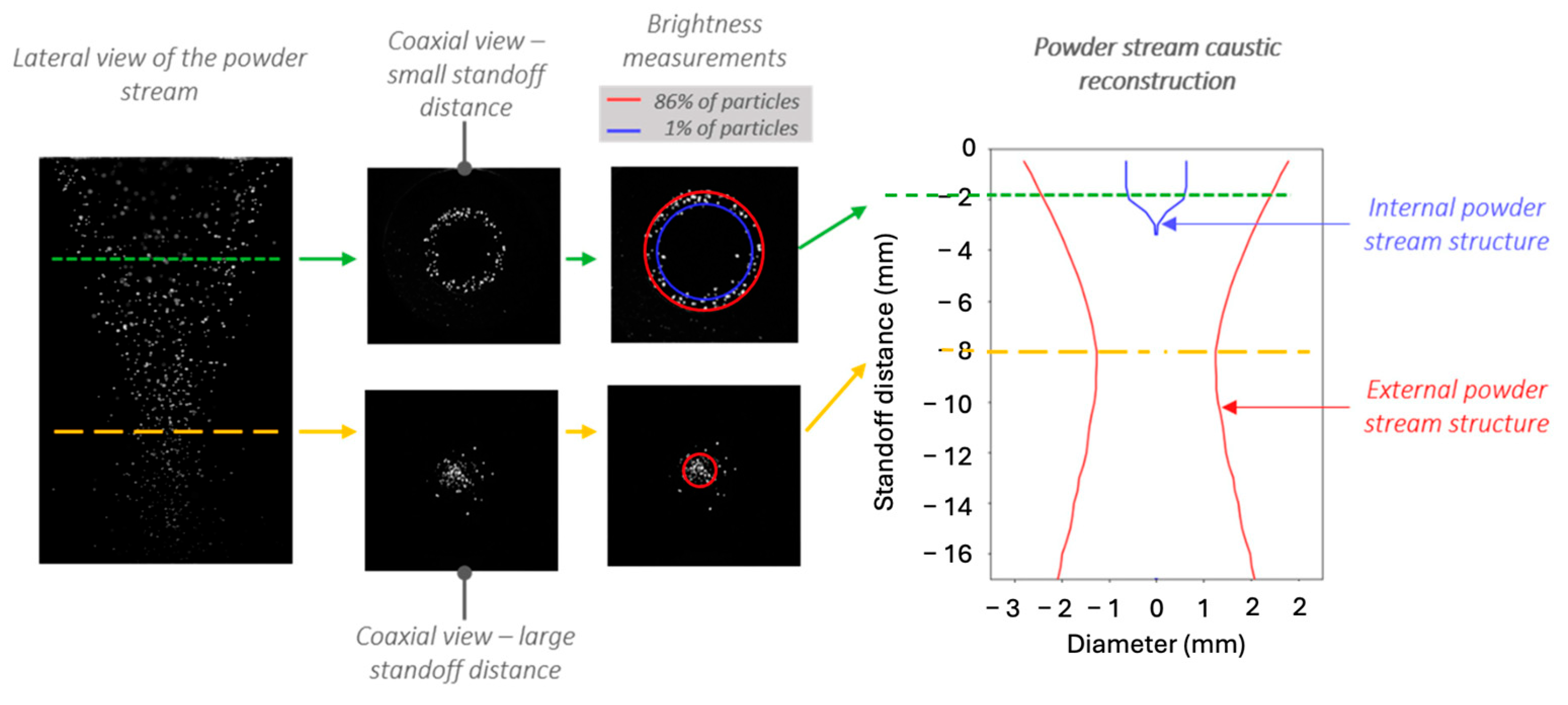

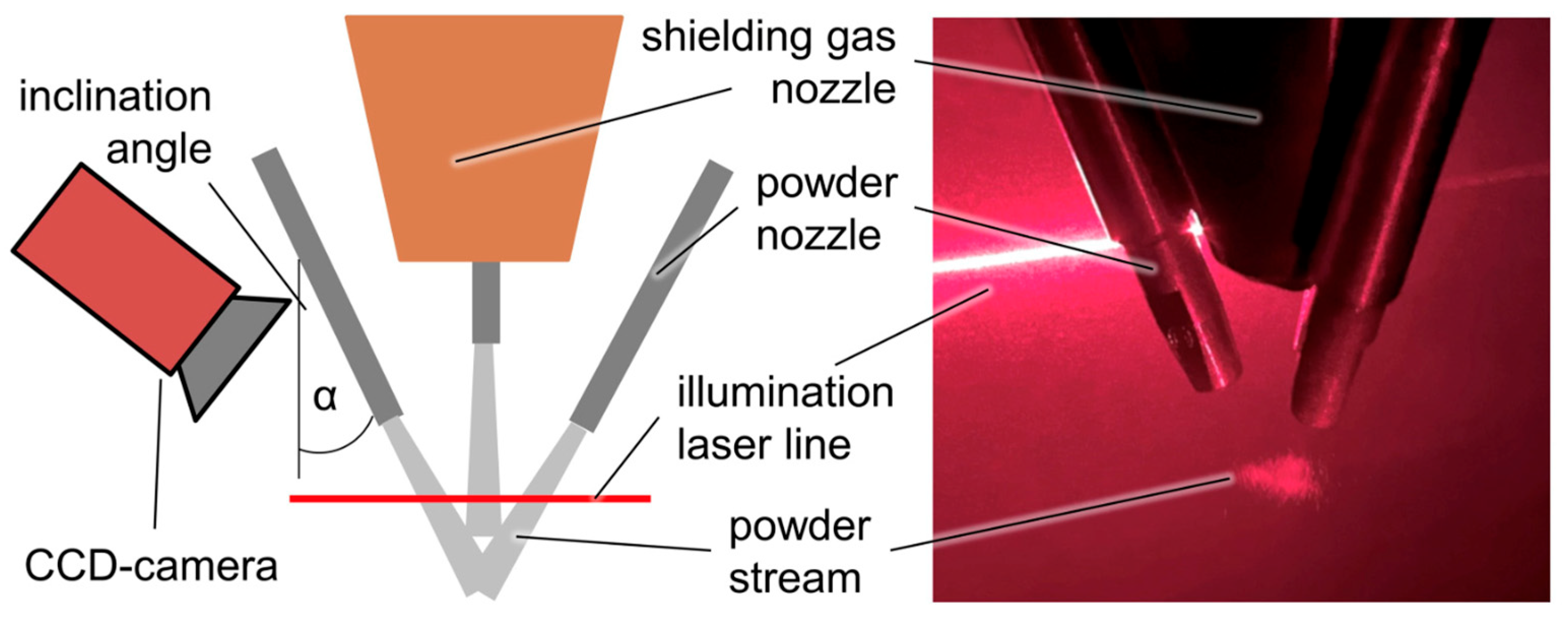


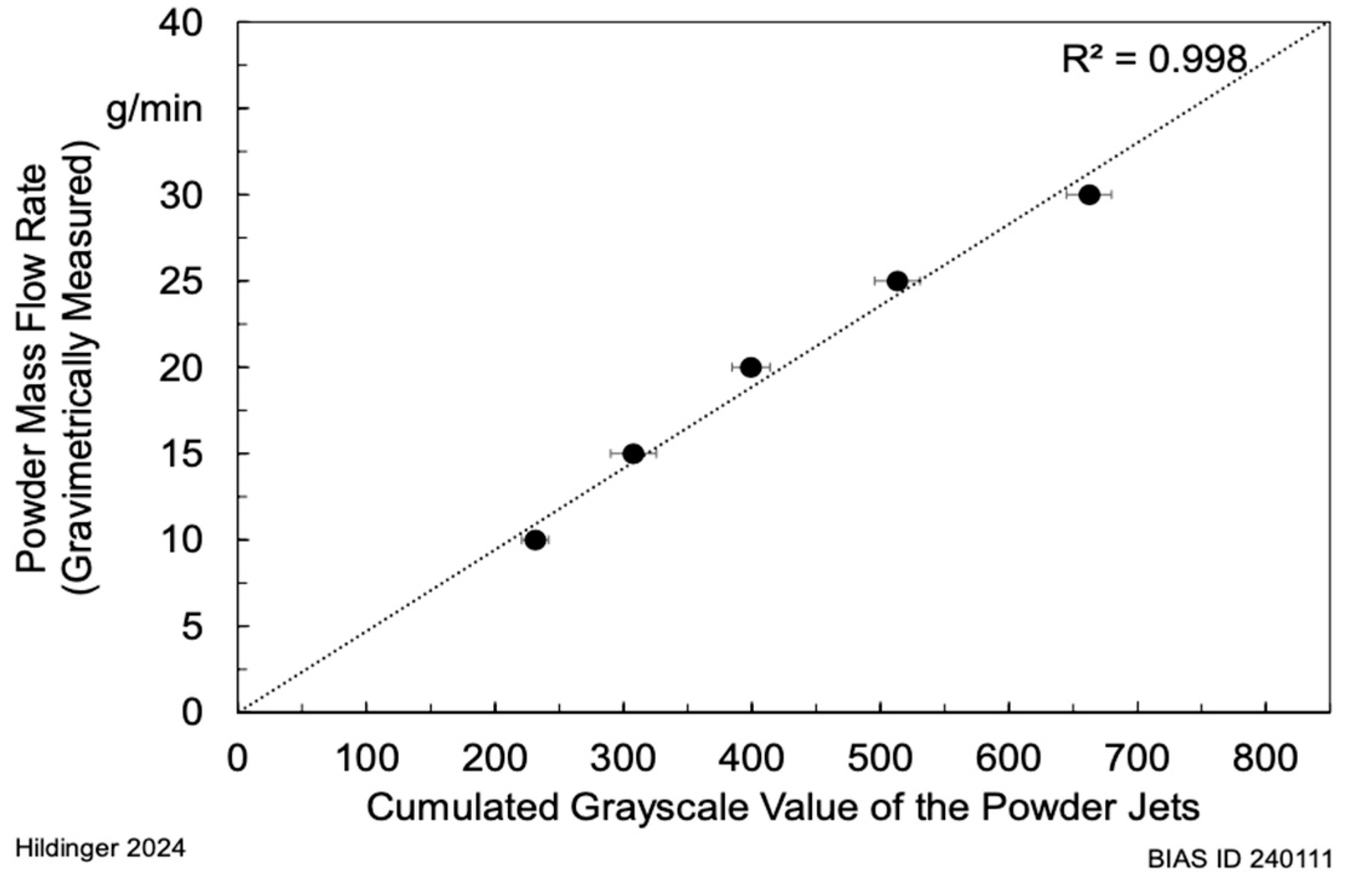

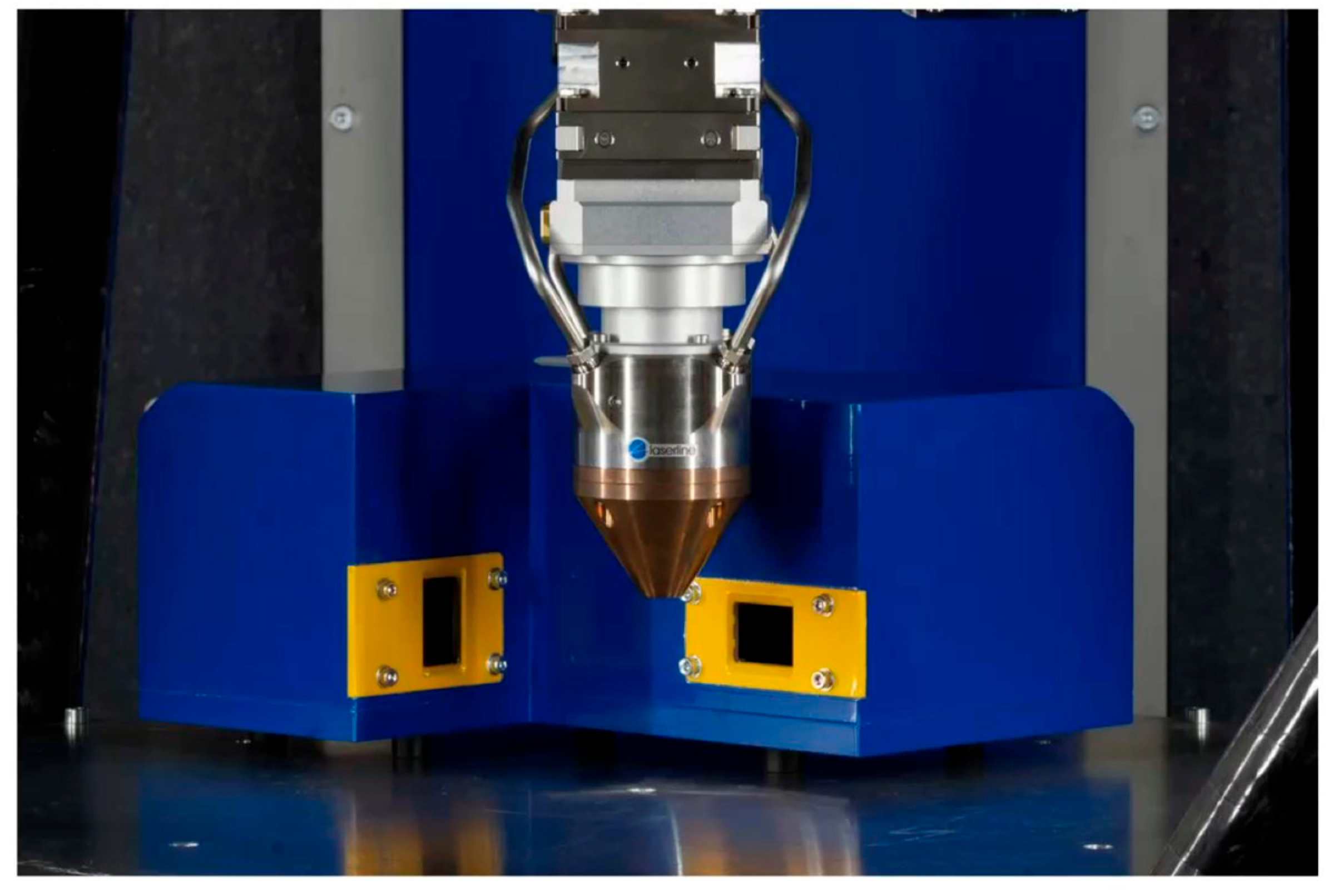
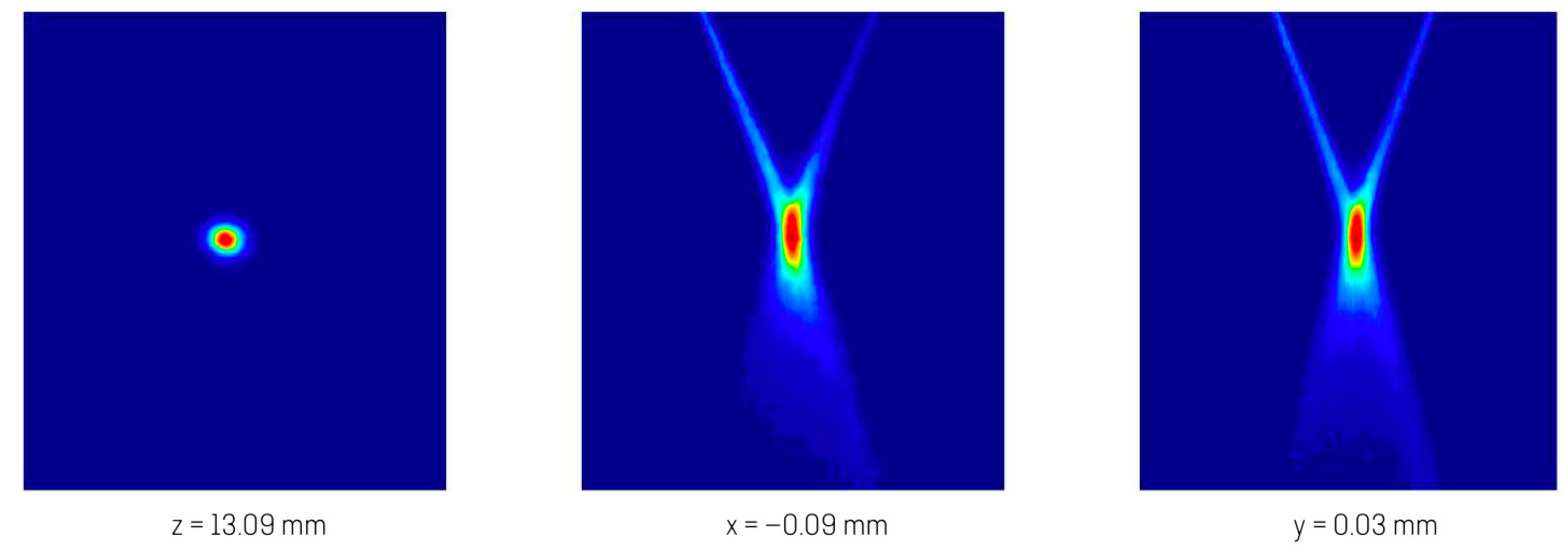
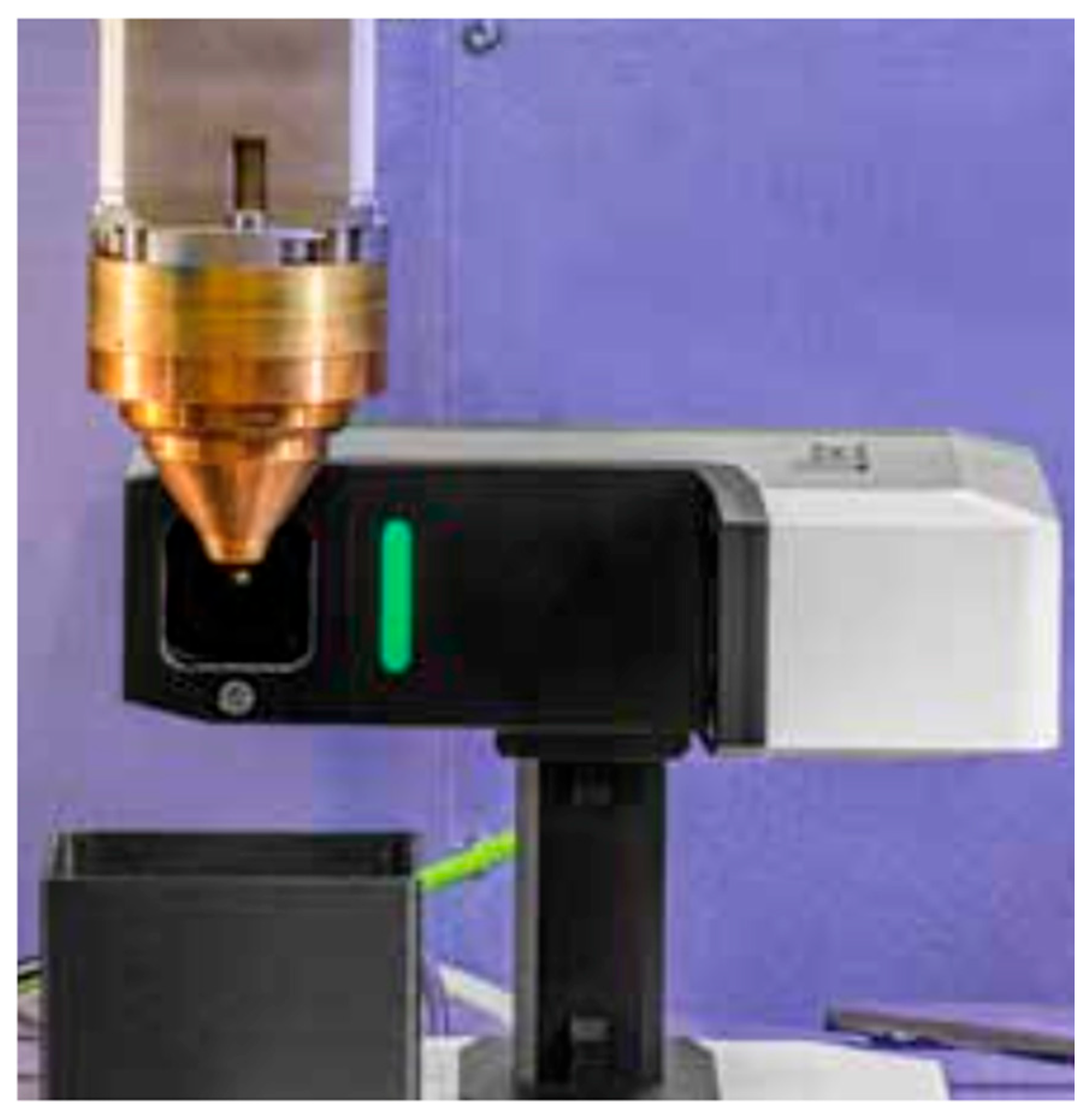

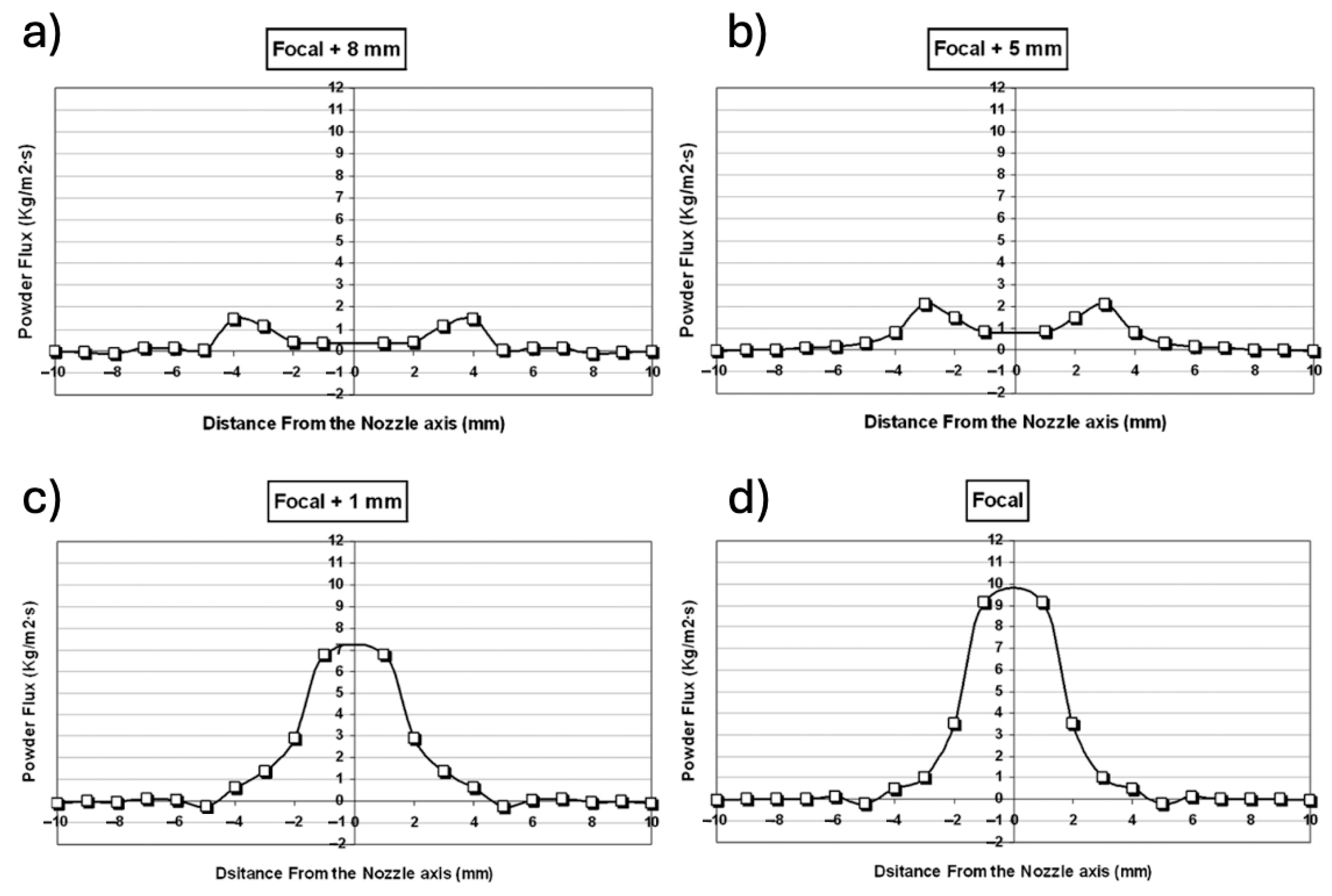

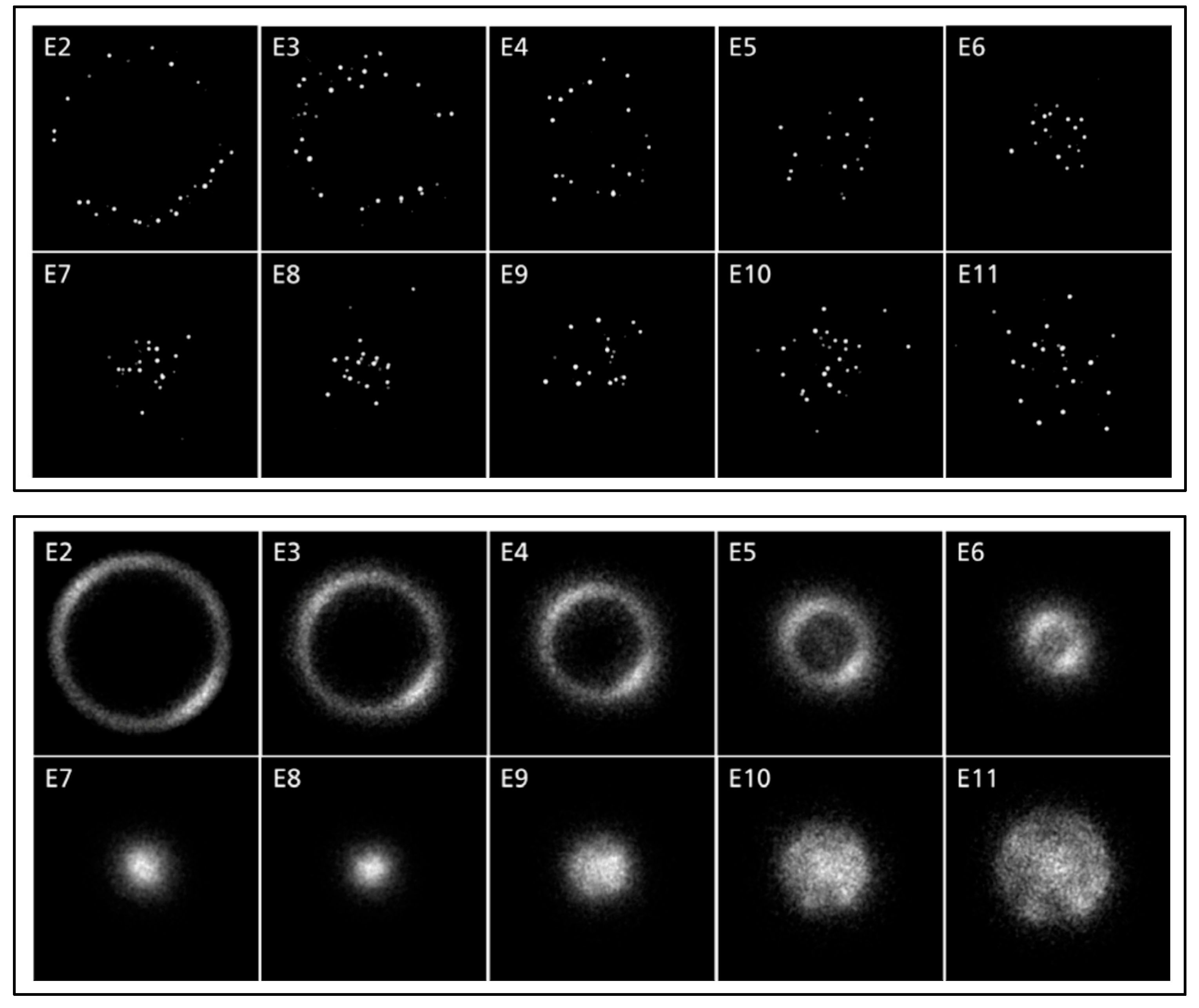
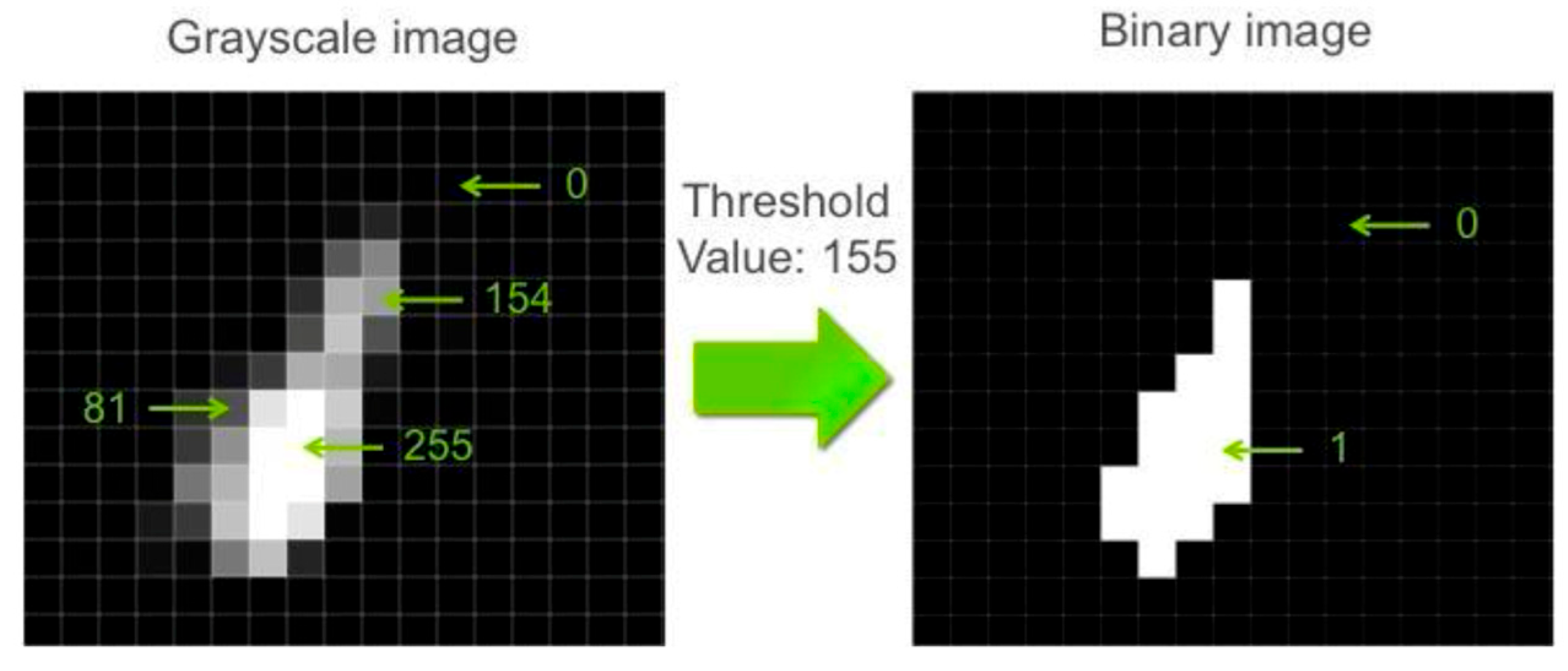
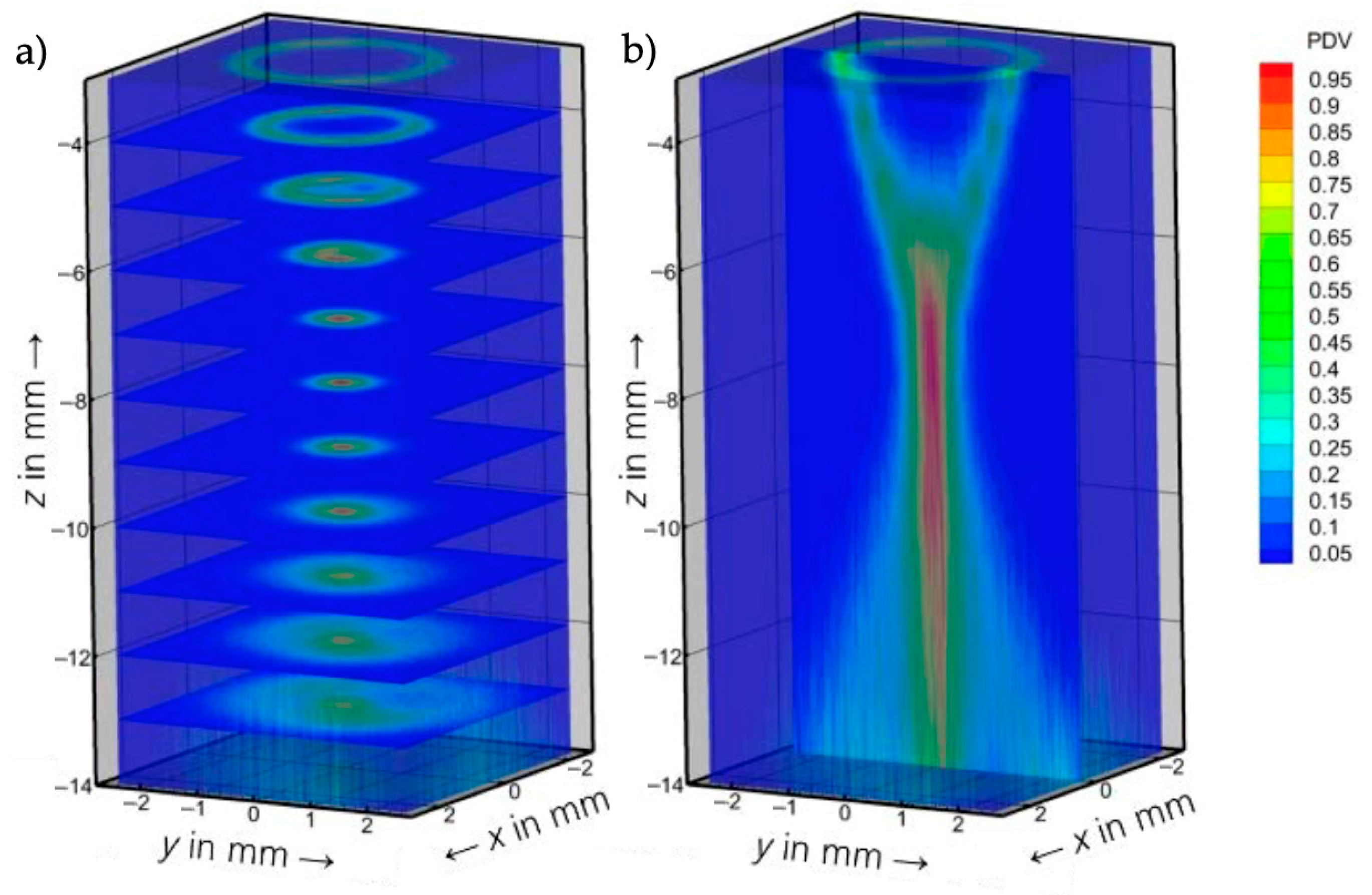
| Ref. | Measured Parameter | Weighting System | Powder Collection Method |
|---|---|---|---|
| [13] | PMF | Scale | Tube connected to open container |
| [14] | Plate with central pinhole | ||
| [15] | Cylindrical containers with concentric holes (varied diameters) | ||
| [16] |
| Camera Setup | Illumination Type | Ref. |
|---|---|---|
| Lateral | Area illumination | [9,10,18,21,22,23,24,25,26,27,28,29,30,31,32] |
| Vertical laser line | [10,17,20,33,34,35,36,37,38,39,40] | |
| Horizontal laser line | [7] * [10,17] ** [20] ** [40] ** [41] | |
| Coaxial | Horizontal laser line | [18,41,42,43] |
| Method Tested | Wavelength | Laser Sheet Thickness | PSD (µm) | SOD (mm) | Df (mm) |
|---|---|---|---|---|---|
| Area illumination | LED lamp—No specific wavelength given | N/A | 45–105 15–45 | 6.90 7.21 | 1.77 0.99 |
| Vertical laser line | 405 nm | 50 µm | 45–105 15–45 | 6.99 7.14 | 1.89 0.95 |
| Horizontal laser line | 45–105 15–45 | 6.95 7.44 | 2.27 1.14 |
| Ref. | Laser Type | Wavelength (nm) | Laser Thickness | Camera Type |
|---|---|---|---|---|
| [17] | Red laser | 650 | 200 µm | CCD high-speed camera |
| [20] | Red laser | 660 | 200 µm | Digital camera |
| [10] | Blue-violet laser | 405 | 50 µm | High-speed camera |
| [33] | * | * | 200 µm | CCD high-speed camera |
| [34] | Blue laser | 447 | 1.93 mm | High-speed camera |
| [35] | Blue laser | 405 | 20 µm | CMOS high-speed camera |
| [36] | * | * | 500 µm | CMOS high-speed camera |
| [37] | * | * | * | High-speed camera |
| [38] | Green laser | 532 | 4000 µm | Digital camera |
| [40] | Green laser | 532 | 200 µm | CCD high-speed camera |
| [44] | Blue laser | 450 | * | CMOS high-speed camera |
| Camera Position/ Viewing Angle | Ref. | Laser Wavelength (nm) | Laser Thickness | Camera Type | Key Output |
|---|---|---|---|---|---|
| Reflection from 45° mirror below nozzle | [20] | 660 | 200 µm | Digital camera | Horizontal cross-sections, powder concentration |
| [40] | 658 | CCD camera | Horizontal cross-sections, max concentration spot and Df | ||
| [17] | 450 | CCD camera | Horizontal cross-sections, Df, SOD, powder density distribution | ||
| In front of nozzle, directly views horizontal sheet | [10] | 405 | 50 µm | CMOS camera | PGJS shape, SOD and Df |
| Lateral to nozzle, directly views horizontal sheet | [7] | 650 | 150 µm | CCD camera | PGJS shape, SOD and Df |
| Positioned at 90° relative to illuminating laser beam | [41] | 520 | 400 µm | CMOS camera | Particle velocity, powder density distribution and Df |
| Ref. | Monitoring System | Laser Wavelength/Thickness | Camera | Propose/Outcome |
|---|---|---|---|---|
| [19,43] | Offline (Powder Jet Monitor) | 810 nm/0.26 mm | CMOS high-speed | Quantitative determination of particle number and position Statistical/numerical model for PDD, trajectories, gas/powder flow Analyse PDD and jet diameters |
| [42,44] | Online (Image-based coaxial) | 450 nm/Not stated | CMOS camera | Real-time monitoring during deposition Detect inhomogeneities and deviations Correlates greyscale with mass flow (g/min) |
| Equipment | Scanning Strategy | Reported Metrics | Portability | Control |
|---|---|---|---|---|
| PowderSpy | Camera Fixed/Laser moves | Powder Distribution in X-, Y-, and Z-axis SOD Df | Standalone | Browse-based (requires no software installation) |
| LIsec | Laser and Camera move together | Standalone or Machine Integrated | Manually by the user or via Message Queuing Telemetry Transport (MQTT) interface of the LIsec software (version 2.13) |
| Symbol | Description | Units |
|---|---|---|
| L | Average luminance (radiance) of scattering element | W·m−2 |
| Iref | Reflected/scattered irradiance at detector | W·m−2 |
| Iinc | Incident irradiance on scattering volume | W·m−2 |
| r | Distance from scattering volume to detector | m |
| n | Number of particles within scattering volume | - |
| V | Scattering volume | m3 |
| k | Wave number, k = 2π/λ | m−1 |
| A | Projected area of scattering volume | m2 |
| F (ξ,φ) | Dimensionless Mie scattering function (depends on size parameter ξ, scattering angle and polarisation state φ) | - |
| Method | Spatial Resolution | Temporal Resolution | Intrusiveness | Setup Complexity | In Situ Suitability | Robustness to Spatter/Smoke | Cost | TRL |
|---|---|---|---|---|---|---|---|---|
| Weight-based | Medium | Low | High | Low | Low | High | Low | Medium |
| Lateral Camera w/Area Illumination | Medium | High | Low | Medium to High | Low | Medium | Medium to High | High |
| Lateral Camera w/Vertical Illumination | High | High | Low | Medium to High | Medium | Medium | Medium | High |
| Lateral Camera w/Horizontal Illumination | High | Medium | Low | High | Low | Medium | Medium | Medium |
| Coaxial Imaging (Offline Context) | High | High | Low | High | Low | N/A | High | Medium to High |
| Coaxial Imaging (Online Context) | High | High | Low | High | High | Medium | High | Medium to High |
| Source of Uncertainty | Assumed Value/Range | Affected Parameter (s) | Propagation Method | Contribution to Final Uncertainty |
|---|---|---|---|---|
| Rebound (Particle loss) | 20% particle loss, particles ejecting from plate upon collision [17]. | Powder mass flow, powder density profile. | Particles that collide with the collection plate or pinhole and bounce away are missed, causing underestimation of powder flow density at the measurement point [17]. | The underestimation of powder concentration by 20% was a result of particle loss, leading to inaccuracies in peak concentration and Df measurements [17]. As example, if powder concentration is 100 mg/m3, but 20% of particles are lost, and SOD is defined as the position where powder density reaches 90 mg/m3 (threshold), it is now wrongly detected at a higher z (further from the actual SOD). As a result, the overestimation of Df by the relative error, in this case, 20%, occurs due to this miscalculation. |
| Scale resolution and drift | Repeatability: 1, 0.12 mg. Settling time: 0.15 s [14]. | Powder mass flow, powder density profile. | Directly affects accuracy of powder mass and dynamic readings, affecting the values used to determine focal properties [14]. | Not explicitly quantified as an uncertainty contribution in the sources. However, it is implied that higher scale accuracy reduces overall measurement error [14]. |
| Sampling time | 21 Hz (dynamic readings) [13]; 1 min (static collection) [15]. | Powder density profile. | Influences the temporal resolution and averaging of collected powder mass flow data. Lower sampling rates can miss transient changes, reducing fit precision, while longer static times help minimise random errors [15]. | Not explicitly quantified as an uncertainty contribution in the sources. |
| Pinhole effective area | Diameter: 0.6 mm [13], 2 to 12 mm [15]. Effective area: 0.83 times the geometric area (for 75 µm mean particle) [14]. | Powder mass flow, powder density profile. | Inaccurate pinhole effective areas, influenced by particle size/shape, directly impacts local powder flow density calculations [14]. | Using geometric instead of effective area can cause 17% powder capture underestimation, affecting accuracy of the powder concentration profile [14]. |
| Source of Uncertainty | Assumed Value/Range | Affected Parameter (s) | Propagation Method | Contribution to Final Uncertainty |
|---|---|---|---|---|
| Sheet thickness | 50 µm [10]; 0.26 mm [19]; 0.5 mm [36]; 4 mm [38]. | Powder concentration profile, particle count. | Thicker illumination sheets capture particles beyond the 2D plane, causing concentration overestimation, blurring, and particle shading [19]. | Affects the accurate count of particles within the desired plane [19]. |
| Pixel calibration | 50 pixels/mm (19.53 µm/pixel) [19]; 0.106 mm/pixel [18]; 20 µm/pixel [31]. | SOD, Df. | Pixel-to-mm conversion errors directly affect the measured dimensions of the powder stream, including SOD and Df [19]. | Not directly quantified as a specific contribution to SOD or Df uncertainty on the sources. However, if SOD is measured at 500 pixels, and pixel size is miscalibrated by 5% (e.g., 20 µm/pixel instead of 19 µm/pixel), then SOD appears as 500 × 20 = 10,000 µm = 10 mm, but true SOD is 500 × 19 = 9.5 mm. This 0.5 mm error directly propagates to SOD and Df values. |
| Thresholding/fitting error | Definitions vary: 86% luminosity (1/e2) [16,29], 10% max intensity [33]. | SOD, Df. | The thresholding criteria and the fitting algorithm used to define the boundaries of the PGJS intensity profile can introduce variations in the derived SOD and Df [10]. | Overall relative errors between simulated and experimental powder utilisation rates were below 14% [50]. |
| Out-of-plane particle | Uniform brightness for particle distribution [40]. | Powder concentration, particle velocity. | Particles outside the illuminated plane, or being obscured by other particles within the plane, can cause “loss-of-pairs” or false signals, affecting the concentration and velocity accuracy [18]. | Not directly quantified as a specific contribution to SOD or Df uncertainty on the sources. |
| Camera noise/saturation | Low SNR (low-contrast images, small particles, short exposure), overexposure, greyscale discontinuities, reduced particle count [10,22,42]. | Particle detection, pixel estimation, velocity and displacement measurement, greyscale/powder concentration distribution, calibration validity, ROIs, precision. | Random noise in the image can obscure particles or generate false signals, impacting particle detection and concentration accuracy. Saturation can lead to a loss of intensity gradient information, hindering accurate profile fitting [31]. | Leads to reduced measurement accuracy, bias errors, precision loss, over/under-estimation of particle and powder characteristics, and increased need for post-processing/experimental optimisation [10,22,42]. |
| Measurement Principle | System Setup | Common Focus of Measuring | Advantages | Disadvantages |
|---|---|---|---|---|
| Weight-based | Pinhole | 3D powder flow density and distribution. Powder mass flow rate. Correlation of time-dependent data with spatial position. | Robust and suited for industrial applications. It does not require complex or expensive optical measurement systems. Provides quantitative powder mass distribution for different diameter rings Enables the detection of inhomogeneities. It can generate a 3D powder distribution profile. | Offline measurement. It can be time-consuming. It lacks the ability to track variations in powder flow velocity and turbulence, limiting its capability to capture the dynamic behaviour of the powder jet. Provides an estimate of powder utilisation rate based on weight measurements, rather than directly measuring the actual powder distribution. |
| Cylindrical Containers | ||||
| Camera-based | Lateral Camera with Area Illumination | Overall PGJS behaviour and dynamics. Particle velocity and trajectories through particle tracking. Relative powder concentration (luminance intensity). Powder stream shape, SOD, Df. | Captures the overall behaviour of the PGJS, suitable for qualitative analysis. Particle tracking across frames enables velocity analysis. It can detect individual particles. It can utilise a low-cost hardware configuration. No laser illumination is necessary for metallic particles. | It does not provide direct measurements of powder mass concentration. Requires post-processing to filter out-of-camera focal plane particles. Extremely high or low particle densities can lead to lower spatial resolution in measurements. It can have high measurement uncertainty for in-process (real-time) approaches due to other process factors like scanning velocity or laser emissivity. |
| Lateral Camera with Vertical Illumination | Local powder mass concentration and particle density distribution within a single plane. Powder jet structure, including SOD, powder-waist diameter, and expansion angle. Particle velocity and motion paths. Particle count and position. | Directly measures local powder mass concentration. Provides the powder jet structure and particle velocity. Offers high-resolution quantitative data and real-time analysis. Captures particles within one plane, eliminating the need to discard out-of-focus particles. Commercially available systems exist (e.g., Ponticon PowderSpy). | It requires precise calibration of the line beam width and measurement area. Particles that deviate from the thin illumination plane may remain undetected, leading to potential inaccuracies in the measurement. The image only provides two-dimensional information. Higher exposure time can result in overestimation of particle density as prolonged exposure may increase the apparent number of particles captured in the image. | |
| Lateral Camera with Horizontal Illumination | Transverse cross-sections (XY planes) of the powder stream at various axial distances. Maximum powder concentration spot and its diameter. 3D powder stream structure (by combining multiple XY planes). Reconstruction of powder stream caustic. | Enables in-plane analysis of powder distributions. Can locate the maximum concentration spot and its diameter. Allow a 3D description of the stream by scanning different Z-positions. Does not require discarding out-of-focus particles. | Requires a sophisticated setup involving precise alignment of the horizontal camera and illumination system, adding to the overall complexity of implementation. It has a limited measurement area, dependent on the positioning of the plane. Requires more processing time compared to area or vertical laser sheet methods. Recognition of edges at the convergence location can be difficult due to high particle interaction, leading to a wider illuminated area and potential experimental error. | |
| Horizontal Camera with Horizontal Illumination | Online, in-process monitoring of the powder stream. Homogeneity of the powder feed and detection of individual powder jets. Quantitative measurement of overall powder mass flow rate. Particle density in a specific horizontal plane illuminated by the laser. | Enables in-process monitoring of the powder stream. It can provide high contrast between the powder and background despite the active processing laser, especially with optical filters. Capable of detecting deviations in powder mass flow early. Determines particle density distribution per plane. | Requires careful selection and tuning of filters and illumination wavelength to ensure sufficient contrast. Particle-particle shading (overlap) can lead to erroneous particle identification at high densities. The measured number of particles is influenced by various factors including illumination line height, exposure time, camera chip resolution, and particle velocity. Necessitates the use of sophisticated and costly optical measurement systems to accurately capture and analyse the powder stream dynamics. |
Disclaimer/Publisher’s Note: The statements, opinions and data contained in all publications are solely those of the individual author(s) and contributor(s) and not of MDPI and/or the editor(s). MDPI and/or the editor(s) disclaim responsibility for any injury to people or property resulting from any ideas, methods, instructions or products referred to in the content. |
© 2025 by the authors. Licensee MDPI, Basel, Switzerland. This article is an open access article distributed under the terms and conditions of the Creative Commons Attribution (CC BY) license (https://creativecommons.org/licenses/by/4.0/).
Share and Cite
Madeira Araujo, J.P.; Gutjahr, J.; Yang, Q.; Mynors, D. Powder-Gas Jet Stream Characterisation Techniques in Laser Directed Energy Deposition: A Systematic Review. Processes 2025, 13, 2995. https://doi.org/10.3390/pr13092995
Madeira Araujo JP, Gutjahr J, Yang Q, Mynors D. Powder-Gas Jet Stream Characterisation Techniques in Laser Directed Energy Deposition: A Systematic Review. Processes. 2025; 13(9):2995. https://doi.org/10.3390/pr13092995
Chicago/Turabian StyleMadeira Araujo, João Pedro, Jhonattan Gutjahr, Qingping Yang, and Diane Mynors. 2025. "Powder-Gas Jet Stream Characterisation Techniques in Laser Directed Energy Deposition: A Systematic Review" Processes 13, no. 9: 2995. https://doi.org/10.3390/pr13092995
APA StyleMadeira Araujo, J. P., Gutjahr, J., Yang, Q., & Mynors, D. (2025). Powder-Gas Jet Stream Characterisation Techniques in Laser Directed Energy Deposition: A Systematic Review. Processes, 13(9), 2995. https://doi.org/10.3390/pr13092995









